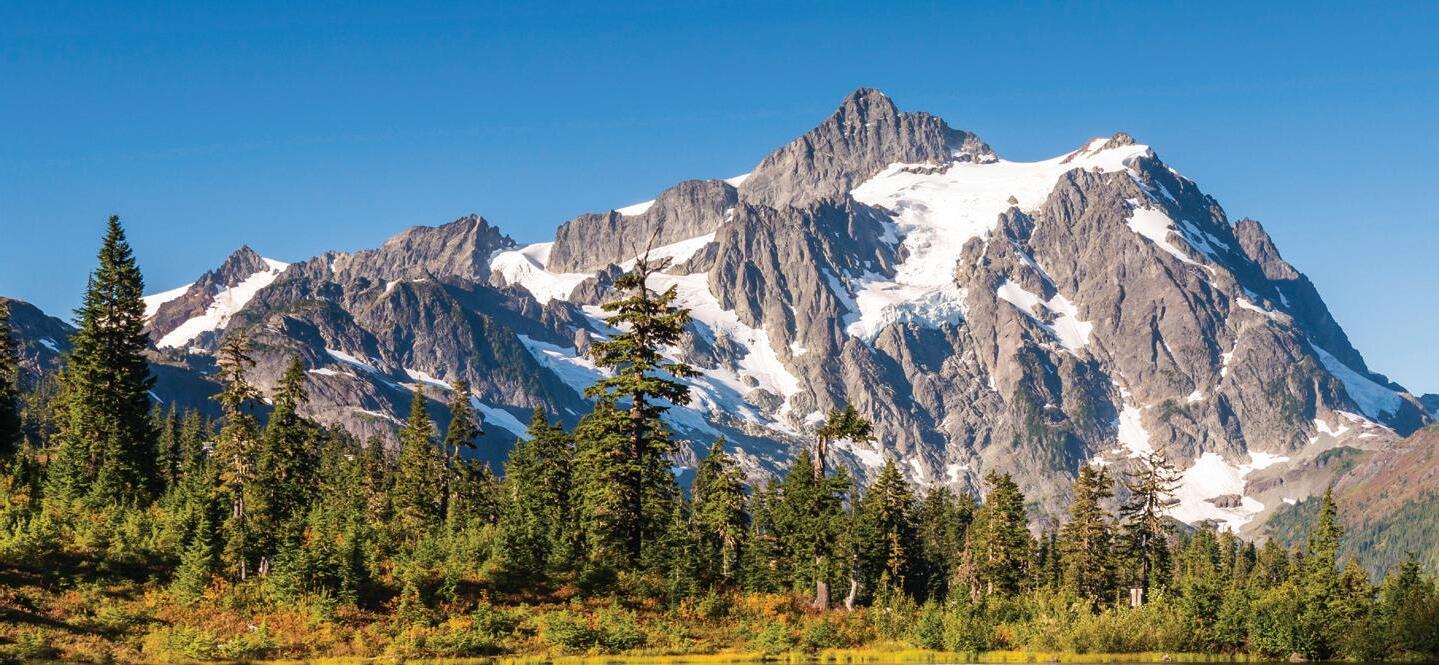KITEBOARDING PUGET SOUND WILDFLOWER HIKES CLIMATE CHANGE ON MT. BAKER

SUMMER RACES AND EVENTS






E VERY SATURDAY THRU OCTOBER: Saturday’s Market By The Sea WEEKENDS THRU LABOR DAY: Historic Plover Passenger Ferry Rides
FRIDAY THRU SUNDAY: Alaska Packers Association Cannery Museum
JUNE 7: Bellingham Scottish Gathering
JULY 4: WECU’s Old-Fashioned 4th of July Celebration
JULY 6-12: Blaine Harbor Music Festival
JULY 12: Art 2 Jazz Street Fair

WECU’s Old-Fashioned 4th of July Celebration
WECU’s Old-Fashioned 4th of July Celebration
DOWNTOWN BLAINE Grand Parade
Car Show • Live Music
Pancake Breakfast
Street Fair & Fireworks
JULY 26-27 : Blaine Art Festival
AUGUST 2 : Drayton Harbor Pirate Festival
AUGUST 16: Whatcom Grooves Summer Music Concert
AUGUST 28-SEPTEMBER 4: OverAll Walls Mural Festival

Stay in Blaine!
Experience the ultimate summer adventure in Blaine by the Sea, where family-fun events and vibrant coastal vibes come together. Stroll through picturesque waterside parks or pedal along scenic biking trails that wind along the Salish Sea. Explore cozy boutiques, art galleries, a maritime museum, and ride the historic Plover Passenger Ferry. Indulge in mouthwatering farm-to-table cuisine that celebrates the season’s freshest flavors. This coastal haven by the Salish Sea offers peaceful moments that rejuvenate the soul.


by Pat Grubb
Typically, this column finishes with the admonition to have fun but be safe. Recently, we received sad news about a North Cascades climbing trip that ended in the deaths of three climbers and serious injuries incurred by the fourth individual. Details are too sparse to determine the cause of the accident – it’s only known that it occurred during a rappel that relied upon a piton or anchor that had been left behind by earlier climbers and apparently failed. We wish the survivor a rapid and full recovery and extend our fullest condolences to the family and friends of those who did not survive.
Safety on the mountain or in any other adventure sport relies on many factors: decision-making, experience, equipment, conditions, and sometimes just plain dumb luck. In this issue, Jason Martin reveals another factor which has grown in importance in recent years – climate change. He reminds us of two other fatal climbing accidents and attributes them to the likely impact of how climate change affects both the mountain environment and how we must adapt to the new reality. Adventurers of all kinds would be wise to consider if climate change is affecting their choice of fun and decide if they need to re-consider how, where, and when they pursue their adrenaline kick. Smoke and flames from increasingly frequent and devastating wildfires, less predictable marine weather systems, higher highs, and lower lows – do you need to re-think how you do things?
Enjoy this issue – it’s full of great writing and photography from some of the Pacific Northwest’s finest writers and photographers.
Remember, have fun but be safe. x

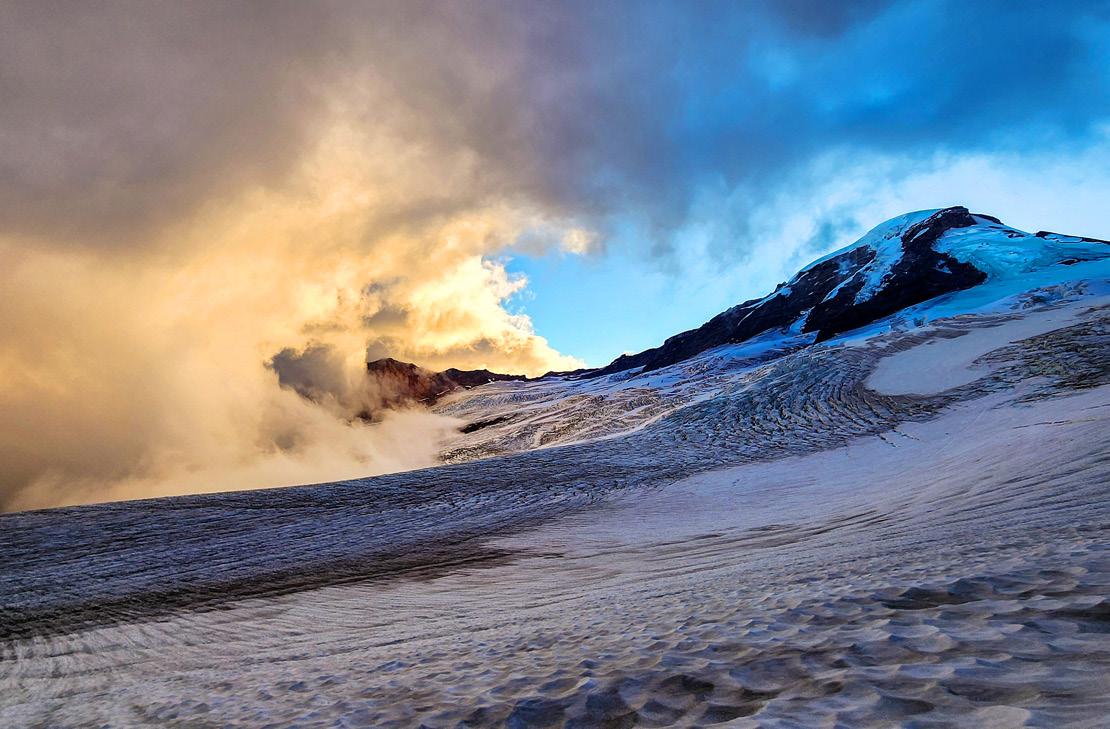
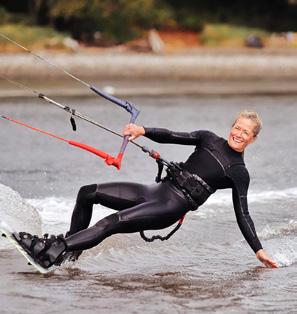
High winds out on Bellingham Bay
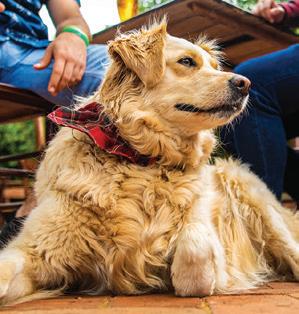
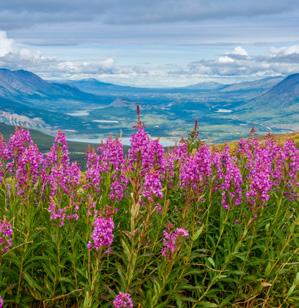
the
and your pooch.

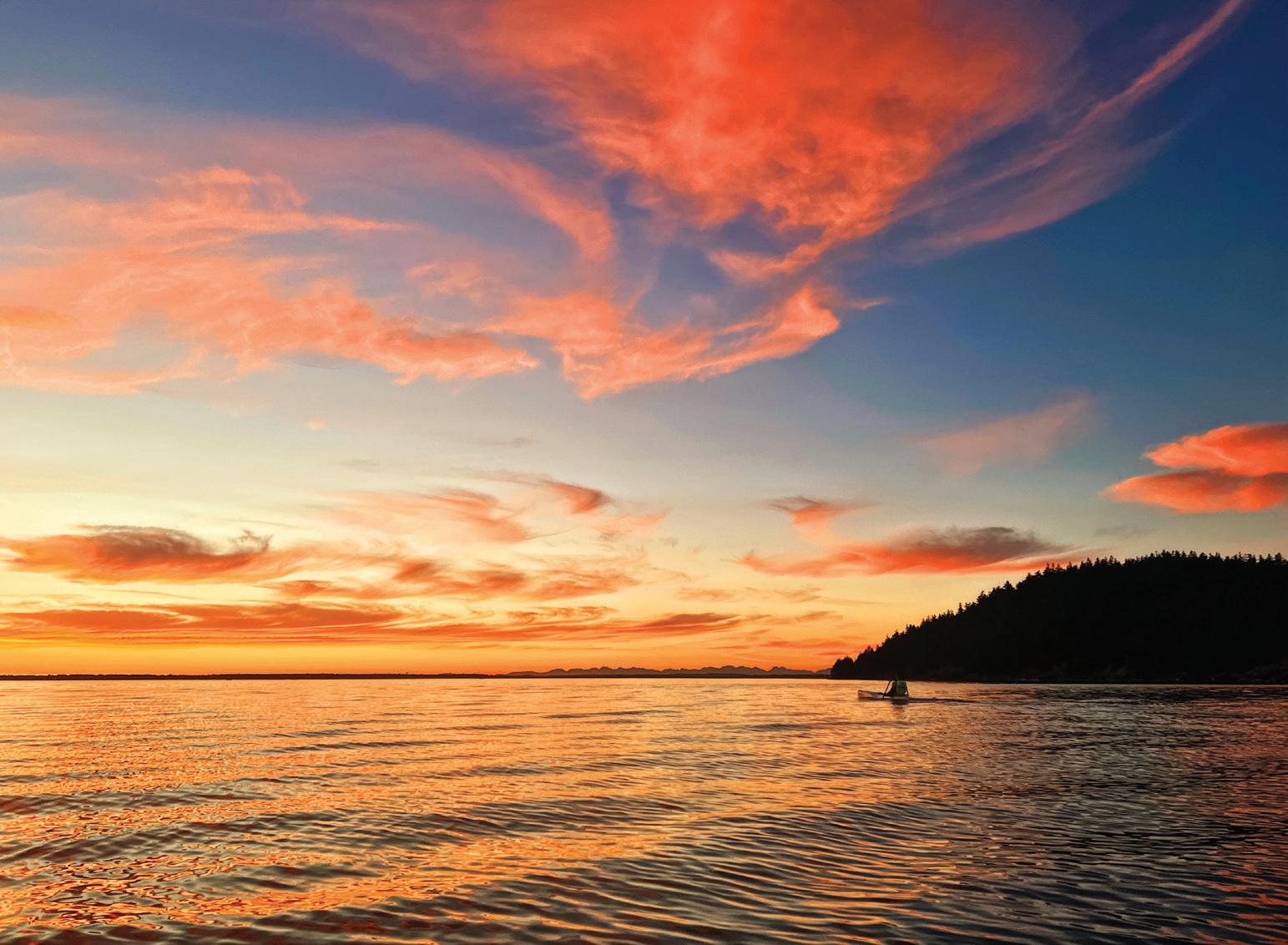
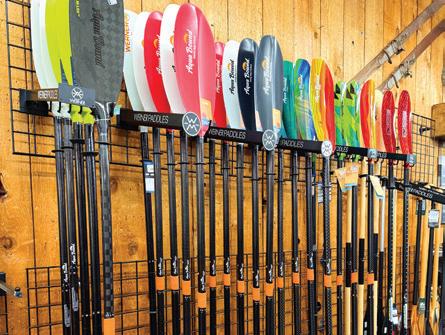
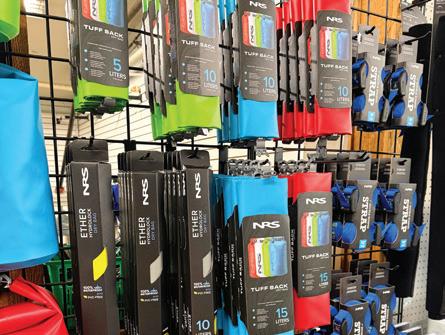



Since 1986
Special publication of The Northern Light and All Point Bulletin
PUBLISHERS
Patrick Grubb and Louise Mugar
EDITOR
Nolan Baker
PUBLICATION DESIGN
Doug De Visser
COPY EDITOR
Grace McCarthy
ADVERTISING DESIGN
Ruth Lauman • Doug De Visser
ADVERTISING SALES
Gary Lee • Molly Ernst
CONTRIBUTORS IN THIS ISSUE:
Daphne Delaney, Ethan Fritzberg, Jake Goldstein-Street, Kris Gray, Richard Riquelme
EMAIL: info@pointrobertspress.com
WEB: www.mountbakerexperience.com
FACEBOOK: facebook.com/mtbakerexperience
TWITTER: twitter.com/MB_Experience
INSTAGRAM: instagram.com/mtbakerexp
If you can see Mt. Baker, you’re part of the experience. Mount Baker Experience is an outdoor recreation guide for and about the Mt. Baker region, distributed from Seattle to Vancouver, B.C. and published by Point Roberts Press, Inc. Locally owned, the company also publishes TheNorthernLight, All Point Bulletin, Pacific Coast Weddings, Waterside and area maps.
Vol. XXXX, No. 2. Printed in Canada. ©2025 POINT ROBERTS PRESS 225 Marine Drive, Blaine, WA 98230 TEL: 360/332-1777
NEXT ISSUE
Fall 2025
Ads due: August 8
Pete Devries inside the wave off the coast of Vancouver Island.
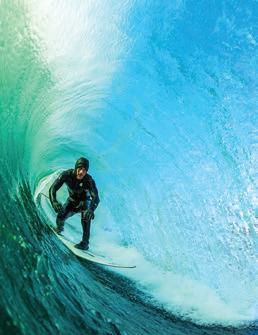

Brett Baunton is a photographer passionate about wild waters and landscapes. His images appear in National Geographic, Smithsonian, Audubon, Backpacker, National Parks, and on a USPS Crest Trail stamp.

Erin Deinzer has worked as a copywriter, travel writer, and editor, and would one day like to ghostwrite an autobiography. As a recently-minted PNW resident, she enjoys exploring her adopted home as well as off-the-beaten path destinations around the world.

Beau Gaughran is a Bellingham-based freelance photographer from Maine. He moved here for the incredible whitewater, year-round splitboarding and mountain playgrounds where he practices his craft.

One of the ski industry’s preeminent photographers, Grant has shot for every major snow sports and outdoor publication worldwide. Grantgunderson.com

Lifelong journalist Eric Lucas lives on a small farm on San Juan Island. He is the author of numerous travel guidebooks, and is a regular correspondent for Alaska Airlines Beyond magazine. He first learned canoeing at summer camp when he was 10.

Jason is the Executive Director at the American Alpine Institute, a mountain guide and a widely published outdoor writer. He lives in Bellingham with his wife and two kids.

Audra Lee Mercille is a Pacific Northwest-based freelance adventurer. She found photography as a way to display her love and gratitude for the mountains and landscapes that inspire her.




Tony is a freelance writer who loves to get out and explore the world with his family. He shares his journey @adventurewithinreach and tonymoceri.com
Mike Nolan is a freelance writer who lives in Port Angeles. His book “Hardhat Days’” will be published this summer by Washington State University Press.
Meg is the co-owner of Kingfisher Bookstore in Coupeville, which has a bit of everything but specializes in the natural and human history of the Pacific Northwest. She like to explore, in person or on pages.
Marcus Paladino is a surf and outdoor photographer living in Tofino, B.C. He strives to have simple descriptions like ‘surf shot’ or ‘nature photo’ fall short. That’s when his work becomes art. Marcuspaladino.com

Dylan lives in Bellingham with his partner Ellie and two cats.

Addicted to altitude, business, adventure. Photographer, athlete, explorer, businessman. @davesummertimes


Matthew is a Bellingham-based adventure photographer with a passion for deep powder, alpine granite and not making it back to the trailhead until way after dark. mtangeman.com.
Colin Wiseman is an outdoor lifestyle and action sports photographer, writer, and producer who has lived in Bellingham since 2007. Follow him on Instagram @colin_wise_man and on the web at colinwisemancreative.com

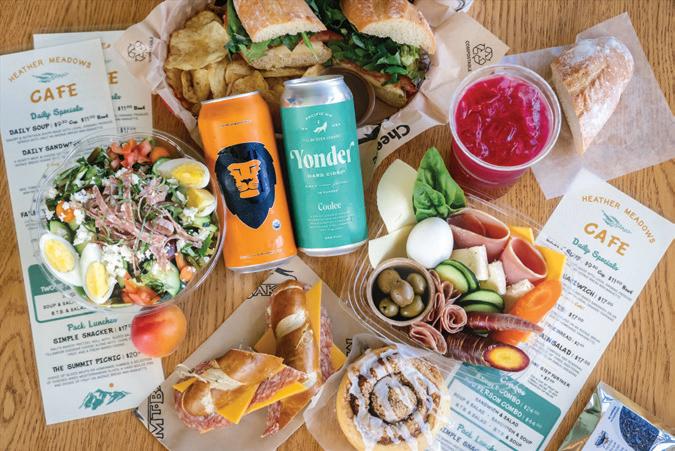


By Nolan Baker
After 30 years in the beer industry, owners Ed Bennett and Janet Lightner announced that 2025 will be the final year for Boundary Bay Brewery’s location on Railroad Avenue in downtown Bellingham.
It’s the end of an era for Bellingham’s longest continually operating brewery, which began in 1995 and has grown to see Bellingham become a beer Mecca known across the world.
Janet and Ed announced their retirement in a November 2024 blog post, saying now is the right time as the building’s owner is deciding to sell.
“Like all good journeys, they must end so a new
adventure can begin,” Ed and Janet wrote.
Mount Baker Experience caught up with the soon-to-be retired Bennett to discuss the legacy Boundary Bay will leave behind, the industry changes they’ve seen firsthand over three decades brewing beer, and what’s next.
The following excerpt has been lightly edited for clarity and length.
Mount Baker Experience: What inspired you to start the brewery, and looking back now after three decades, did you ever imagine it would grow into what it is today?
Ed Bennett: I was attending UC Davis to get my
Master’s degree in wine chemistry (Enology), beginning in the Fall 1986. UC Davis is well respected in their curriculum on premium wine making and grape growing. UC Davis at that time was also the only public university in the country with a malting and brewing program.
The craft beer industry was just getting going and I was at a central location of the movement. Anchor Brewing in San Francisco and Sierra Nevada in Chico were becoming major breweries. While I eventually received my Master’s degree from UC Davis in 1990, I continued to keep an eye on the craft beer industry.
I worked in the wine industry in Northern California, but craft beer seemed like an opportunity to relocate to the Pacific Northwest where I was from. We began construction in July 1994 and opened the brewery and restaurant in September 1995.
There were only 276 craft breweries in the country in 1995, and just a handful of them in Washington State.
Looking back after three decades, I would not have imagined how we grew. We now have over 100 employees and for several years, we were considered to be the largest brewpub in the United States. We have wholesale distribution primarily in Washington State. We sell both draft and packaged products like cans and bottles, retail and wholesale. We have won numerous awards for our beer and have been considered one of the pioneer breweries that has had an impact on the craft beer industry over 30 years.
















MBE: What were some of the biggest challenges you faced in the early years, and how did you overcome them together as both business partners and a couple?
EB: The craft beer industry was much different in 1995. Today, everything needed to set up and run a brewery can easily be obtained. Back in 1995, I had to work with an engineer to design and build custom-made brewery equipment.
In addition to setting up and running a brewery, I had never run a restaurant before. I had to rely on the people that we hired with restaurant experience.
That is where Janet comes in. She helped before we opened and joined the staff soon after we opened. She had an immense background in the restaurant industry. She was a perfect fit to take the brewery restaurant to another level and is still a major contributor to the restaurant and brewery operations.
MBE: Craft beer has evolved dramatically over
MBE: What are some of your proudest moments from your time running the brewery, whether it’s a particular beer, event, or community impact?
EB: While developing world class beers, working with the Bellingham/Whatcom County community is central to our business plan and one of my proudest . I always thought that I was at a point in my life that I wanted to give back to the community that I had a part of.
One of the proudest moments is when somebody comes up to me and thanks me for everything Boundary Bay Brewery does for the community. There’s lots of examples. Fundraising, producing specific event and organization’s beers: Ski to Sea ESB, Race Day IPA, Bellingham Bell’s Fielder’s Choice IPA, Traverse IPA, Roller Betty’s Insubordination IPA, the list goes on.
It helps when making a product that can be used in so many ways to help raise funds for an organization. It’s a long list of organizations. One of the best examples is Max Higbee Center, when we came up with the beer festival idea and taught
craft beer, but also an inviting event and concert space?
EB: I had traveled in Europe a lot before I opened the brewery and saw many great beer gardens. That gave me the desire to have a space in Bellingham that can be used for so many things. Beginning and end of races, community fundraisers, city events, weddings, memorial gatherings, and a place to come to enjoy great music! We also want to share the beer garden with families of all ages.
MBE: Running a business as a couple can be intense. How did you maintain a healthy work-life balance over the years?
EB: We try, but to be honest it is difficult to maintain a “healthy” work-life balance. We have committed so much of our lives to the brewery and restaurant, we feel it is time to back away from the day-to-day operations.
Janet and I, along with Janet’s children, Casey, Madison, Bailey and the staff who have been with

Elevate your ride. Wing foiling rentals, lessons, and all the gear to help you reach new heights this summer.




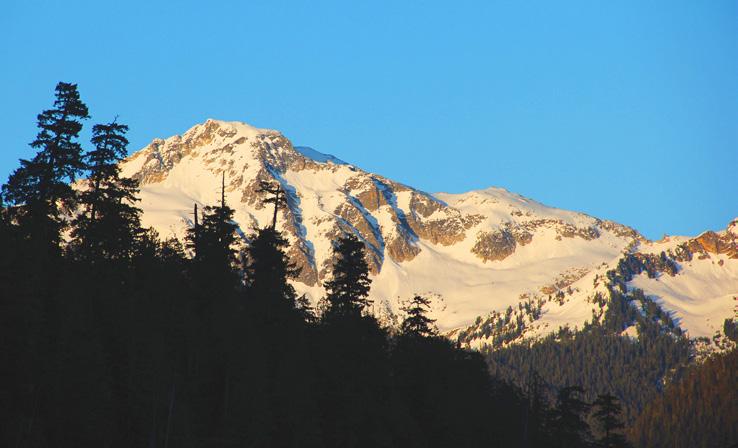
Memorial Day Weekend has come and gone, meaning summer is in full swing. That’s especially true at the North Cascades Institute, which announced a full slate of summer events, educational opportunities and excursions for the public to join. Read on to find an event to tag along during the Pacific Northwest’s brief – but beautiful – sunny season. For more info, visit ncascades.org.
Spring Birding in the Methow Valley
Methow Valley
June 6 – June 8 (overnight)
Cost: $350
Migratory birds are returning to nesting grounds in the Methow Valley by early June, and avid birders will not want to miss it.
Join NCI instructor Libby Mills for
an exploration of seasonal birdlife in the North Cascades with traverses through diverse habitats like sagebrush steppe, riparian aspen, cottonwood, willow and Ponderosa Pine forests.
The class will be based out of Pearrygin Lake State Park with camping available – or hotels just a 10 minute drive away in Winthrop – and early




mornings planned to see these beautiful birds.
Some species nesting in the Methow Valley in spring and summer travel from as far as Central America and the Andes Mountains.
The camping-based program includes a Friday night potluck dinner, but attendees should bring their own food and camping equipment otherwise.
Amphibians of PNW Ponds and Wetlands
Nooksack River Valley
June 7, 9 a.m. – 5 p.m.
Cost: $160
Birds aren’t your thing? Need something a bit more … slimy?
The North Cascades Institute is offering a one-day field class in the wetlands of the South Fork Nooksack River Valley and Samish River area, important habitats for the threatened Oregon Spotted Frog. Open to ages 12 and up, the class is led by biologists from the Whatcom County Amphibian Monitoring Program and provides hands-on experience identifying local amphibians and their life stages.
Participants will engage in amphibian searches, learn about their natural history, and explore habitat relationships. Tuition includes access to a two-session online course that offers background on frogs and salamanders of the “Puget Trough,” enhancing the field experience.
This combined virtual and in-person program offers a thorough introduction to amphibian ecology and conservation efforts.
Carving and Conservation
Environmental Learning Center
July 19, 9 a.m. – 5 p.m.
Cost: $150
NCI is offering a one-day work-
shop titled “Carving and Conservation: Wildcrafting as a Tool for Stewardship and Connection” at the North Cascades Environmental Learning Center.
Led by expert spoon carver and naturalist Brendan McGarry, this class invites participants to learn the art of carving wooden spoons using simple hand tools.
The workshop emphasizes the value of creating handmade objects from local materials, providing a break from our screen-centric world.
Participants will explore how mindful wood harvesting can help foster communities and deepen appreciation for local ecosystems. The class encourages reclaiming knowledge about the origins of material objects, promoting ecological stewardship, and connecting with the natural world through the craft of wildcrafting.
Artist Point
July 26, 8 p.m. – July 29, 2 a.m.
Cost: $145
Experience the magic of the night sky like never before at Artist Point in this immersive photography workshop led by astrophotographer Juan G. Aguilera.
You’ll learn how to capture stunning images of stars, the Milky Way, and iconic peaks like Mount Baker and Mount Shuksan using techniques such as light painting and astrophotography settings.
Designed for photographers of all skill levels, the class encourages both creative expression and technical mastery in a breathtaking natural environment.
To make the most of the workshop, bring a DSLR or mirrorless camera with manual controls, a wide-angle lens, and a sturdy tripod. x




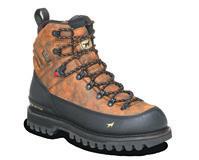


By Nolan Baker

After years rotting away as a watery, derelict ruin, Little Squalicum Pier is open to the public for the first time since its construction more than a century ago.
The 1,248 foot pier was built in 1912 to deliver cement products to offshore barges, hasn’t been used since the 1980s, and was transferred to the city of Bellingham in 2021, according to a press release from Bellingham Parks and Recreation.
“You can’t look at the pier without wondering what it’s like to be out there,” parks and recreation director Nicole Oliver said. “Now, anyone can experience Bellingham Bay from a new perspective.”
That new perspective is truly unique, with the pier earning the title of longest public pier in Washington state. On a clear day from the edge of the pier, you have unobstructed, 360-degree views of the San Juans, Lummi Island, all of coastal Bellingham and Fairhaven, and even Mt. Baker peaking over the foothills.
Funding for the extensive renovations of the pier totaled $1.6 million, provided by the city’s Greenways Levy, a tax used specifically to create and update new and existing trails to connect neighborhoods across Bellingham.
One of the ultimate goals of the Greenway Levy is to create an uninterrupted Bay to Baker Trail, a foot and bike trail from Bellingham Bay to Mt. Baker. The city of Bellingham has been slowly purchasing private and state-owned property along the proposed route, including a recent purchase of 116 acres of land along Mt. Baker Highway from the state Department of Natural Resources for $2.19 million in 2024.
Little Squalicum Pier is the official starting point of the trail, with the trail heading northeast to Squalicum Creek Park, then north to Cornwall Park.
Gaps still exist in Bay to Baker Trail, but Little Squalicum Pier is truly a stunning start to what will – one day – be a world class urban trail.
“Bellingham is a unique place, and this is another amenity that sets us apart,” Mayor Kim Lund said during the April unveiling ceremony. “As we did with Taylor Dock, we are helping to transform our waterfront from a place with an industrial past into a vibrant hub for recreation and wildlife.” x

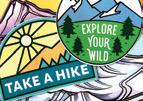

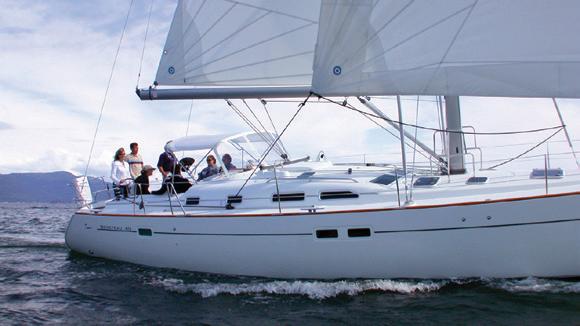





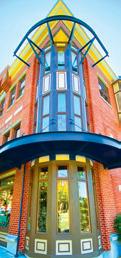


Photos by Ethan Fritzberg and Kris Gray


ellingham Bay is where adrenaline and artistry collide. With steady winds, sweeping views of the San Juans, and a tight-knit crew of locals who dance across the waves, this is ground zero for the Pacific Northwest’s wind-driven stoke. Whether it’s wing foilers carving glassy swells or kiteboarders catching air, Bellingham Bay isn’t just a playground, it’s a proving ground. Dive in. x
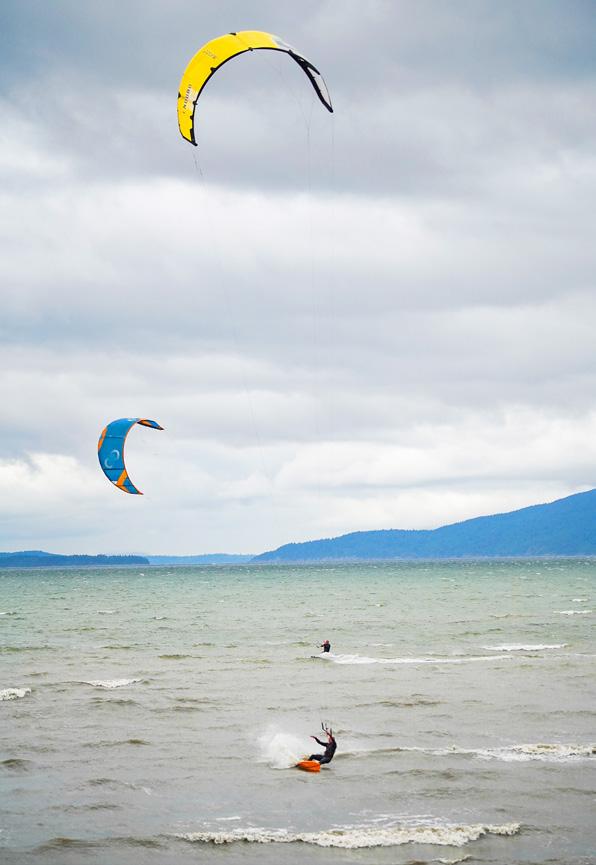


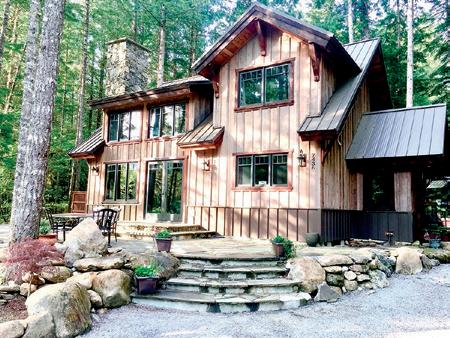
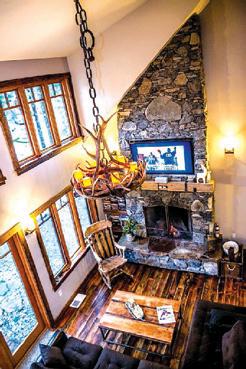

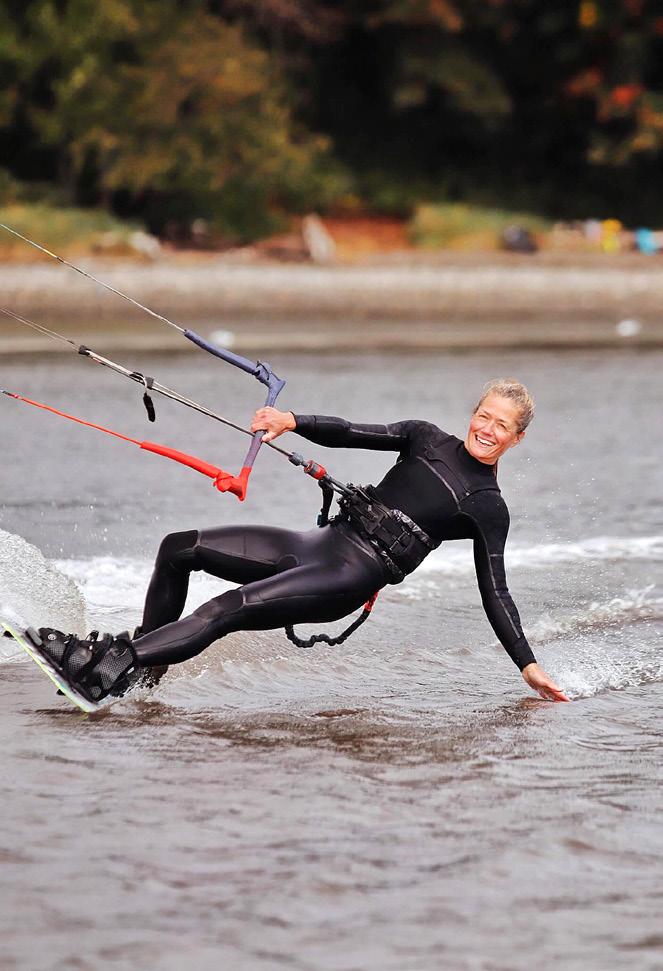







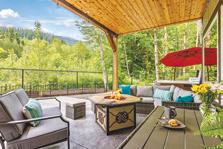

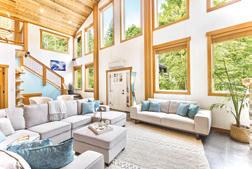



By Jason D. Martin

In the fall of 2024, climate change on the glaciers of Whatcom County likely took its first victims. Two individuals fell on separate mountains, one on Mt. Shuksan, one on Mt. Baker. And in each case, the fall was fatal. Those new to mountaineering learn how to use ropes, crampons and ice axes to climb moderate routes like the Coleman-Deming and the Easton Glaciers on Mt. Baker, and Fisher Chimneys and the Sulphide Glacier on Mt. Shuksan. Historically, basic skills with these tools were all that was required to successfully summit one of these peaks. If one fell on a snowy slope, it was reasonable to believe that with the proper use of an ice axe you could arrest a fall.
But that is changing.
In the spring, the standard routes on Mt. Baker and Mt. Shuksan are beginner to intermediate level objectives. But as the season progresses, the mountains evolve. The security provided by snow that historically lasted throughout the duration of the summer no longer offers the security that it previously presented.
Over the last several years, the snow has been melting off glaciated peaks earlier and earlier, exposing the ice underneath. Occasionally the newly exposed ice is also peppered with rocks and dirt. This has long been a normal phenomenon on the lower flanks of the mountains, but now we’re seeing it much higher, and often in much more hazardous areas.
The basic use of an ice axe and crampons are no longer enough for late season ascents. And this is where the two falls in 2024 come into play. It’s likely that dry glaciers – glaciers without snow on them – contributed to the two falls. When one slips in such a setting, the ability to self-arrest is inhibited by the fact that it is much harder to engage the ice axe pick to stop a fall. Ice axes were designed to arrest falls on snow, not on hard glacial ice.
In other words, late season mountaineering has become much more akin to ice climbing.
Mountaineering Techniques for Dry Glaciers
In classic glacier mountaineering, there are two
hazards that climbers are constantly balancing. The first hazard is falling into the mountain. And the second hazard is falling off the mountain.
As the season progresses, it becomes less and less likely that one will fall into the mountain due to the fact that hidden crevasses reveal themselves and the safest routes become obvious. As the snow disappears and blue ice exposes itself, falling into a hidden crevasse becomes more and more unlikely, while slipping and sliding into one, or sliding off the mountain completely, becomes much more likely.
There are techniques that may be used to decrease the hazard of falling off the mountain in these kinds of conditions. Following is a simple breakdown of skills that climbers should practice before engaging in late season glacier climbing:
Crampon Technique
French technique is the term broadly used for crampon techniques that allow all of the spikes to engage with the ice. There are a few different tactics that allow one to engage all the crampon points.
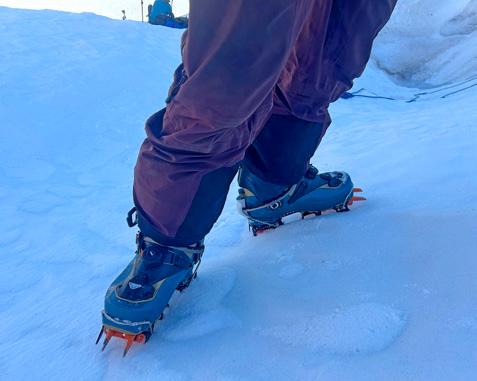
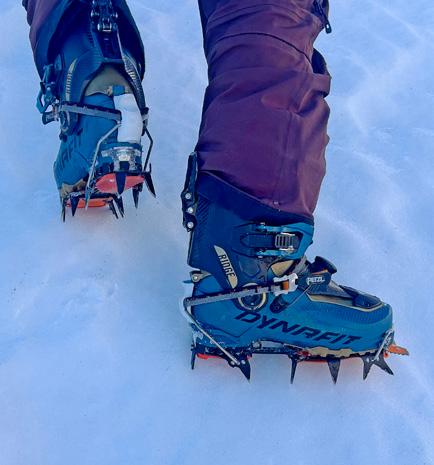
First, the duck walk, or the duck foot technique. This is when your feet are splayed out like duck feet as you move up the slope. Your ankle will not bend far enough to walk straight up, so as the terrain hits 30-degrees or so, you have to adjust your steps to ensure that all the crampon points are engaging.


Second, as the terrain steepens, you will begin to do the crossover step, switchbacking up the slope. The idea is to step over your uphill foot with your downhill foot in a way that allows you to engage all the points on the bottom of your feet. This takes practice to do well. And you know you’re not doing it right if the crampon points on the bottom of your feet are not engaged.
Third, the American technique. This is for steeper, more hazardous terrain and could be used both going up and down if needed.
The American technique is a mix of foot positions. One foot is in a French flatfoot position, the other foot is “toe-in” engaging the front points. Consider it a mix of ice climbing with one foot and glacier walking with the other
When descending, it’s important to consider your crampon points as well. If you are traversing back and forth on steep icy terrain, it is unlikely that all of your points are engaging. It may be scary, but often going straight down, with toes splayed out a little bit to avoid tripping, is the best technique. This allows your ankle to bend enough for all the crampon points to engage the ice. If the terrain feels extremely insecure, it is possible to shuffle down the slope sideways. In other words, your toes are parallel to the slope, you step down with one foot and then the other, allowing your ankles to bend sideways to engage crampon points. This is very slow, but it is also very secure.
Many people see ice axes as the combination of a walking stick and a way to arrest a fall. In late season icy conditions, this is the wrong way to conceptualize ice axe use.
There are nine principal ice axe techniques. There is not room here to cover each of them, but it is important for you to be aware of dagger positions. These are positions where you engage the pick of the ice axe while holding onto or near the head of the tool.
In low dagger, your hand is on the adze, with the pick in the ice at waist level. In middle dagger, you’re holding the shaft of the axe right under the head and placing the pick at chest level. And in high dagger, your hand is over the top of the head of the axe and you’re placing the pick at head level or higher.
Dagger positions are incredibly secure. And indeed, when you use two ice axes in dagger position, even on 40-degree terrain, your security is far better. The likelihood of falling off the mountain decreases dramatically.
As the season progresses and there’s more exposed ice, a rope team can move on a moder-
ately steep glacier together with a reasonable level of security by placing ice screws between them. Though the terrain is theoretically easy, this ensures that the team is always attached to the mountain. And though the team could still get pulled down by an unexpected fall and there might even be injuries, it’s unlikely that a fall would result in a fatality.
The downside of this technique is that often the ice is dirty. Ice screws may be damaged on a late season climb of something like the Roman Wall on Mt. Baker.
The most secure technique of all is to literally pitch out steep terrain when it’s icy. This may feel like overkill going up, as you are often more stable on the ascent. However, when exposed and going down, it could make sense for the strongest person on the team to belay the others down while clipped into an ice screw. Once the team has gone down a rope-length, they could place a screw, clip into it and belay him down.
Climate change is making the mountains more dangerous. It is essential for late season climbers to take icy terrain seriously. For some this may mean going up a day early to practice ice techniques. For others it will mean a special trip. But no one should be high on Baker or Shuksan without solid moderate glacier ice skills. x
Many glaciers in the late season have rocks and boulders that melt out and tumble down the slope. For this reason, it’s recommended that mountaineers wear helmets on slopes where this is taking place.
Of special note is the Colfax Icefall. This is an active icefall zone on the north side of Colefax Peak. There is hazard on the Coleman-Deming route between approximately 8200 and 8800 feet. It is strongly recommended that climbers do not take breaks in this zone.

Dawood
Dhada practices middle dagger technique on the North Side of Mt. Baker.

By Erin Deinzer
What does the perfect summer day look like to a dog owner and their furry friend? To answer that question, I planned an overnight getaway and brought along Chaska, my Mexican rescue pup, for her take on the Bellingham-based itinerary. Here’s how our day played out:
Erin: Chaska had already eaten but I was in serious need of a cuppa, so we started the day at Whole Foods on Lakeway Drive. We sat outside as I sipped my cappuccino, enjoying the warmth of the summer sun.
Popping into Mud Bay next door, Chaska let me know which snacks she was interested in while I grabbed a few chew toys for the overnight stay.
Chaska: Who doesn’t love a stop at the Mud Bay treats buffet? I did some strong tail wagging at the ones without chicken meal, but I kept wondering: When does treats time begin?
Erin: Driving out to 745-acre Lake Padden Park, we enjoyed the windows-down weather and the blossoming trees and flowers along the way. When Chaska arrived last year after her trip north, it was the first place I took her in Bellingham. A 2.6-mile footpath circles the lake, and at the far end there’s a short pier where you can fish or watch people (and dogs!) in kayaks or on standup paddleboards. Even if you don’t bring your own equipment, you can rent them at the lake from either Yeager’s Sporting Goods or the city of Bellingham.
But we were there for ground-based activities,
so we set out for a brisk walk. At one point, riders on horseback descended from a trail. Chaska was mesmerized by them, and I wondered if she’d ever seen a horse before.
Looping back to the parking lot, we popped into the enclosed dog park. Gregarious mutts frolicked in the field, chased balls, and scurried around inside a short tunnel.
After playing fetch (and rewarding Chaska with a few treats), we sat at a picnic table overlooking the lake. I nibbled on a pre-packed sandwich while she sat on the grass, captivated by the floating lily pads.
Chaska: At the dog park I saw lots of friendly faces and met a kooky canine who followed us around begging for a treat. The off-leash area was fun, but my favorite part was meeting the longhaired animals and watching squirrels darting up trees.
Erin: Most gal-pals like to get mani-pedis, so I took Chaska to Shake & Shine for hers. Once inside, we were led to the nail-trimming station to get her nails clipped and polished, then she finished up with a sudsy bath.
Chaska: I am not a fan of the Dremel tool. Still, the lady who used it was nice, and my nails felt good afterwards. Plus, I got another treat.
Erin: There are several dog-friendly properties around town, but the historic Hotel Leo appealed to me. The lobby is decorated with Moorish-style tiles and evokes an old-world charm. I also appreciated having a bar (Amendment 21) onsite in case I wanted a nightcap.
Once we got settled into our room, we explored the hotel. Then it was time for a quick change for
me and an in-room dinner for Chaska.
Chaska: The Hotel Leo was easy to navigate on a leash. I also enjoyed the outdoor patio for a bit of fresh air. But what I really liked was the fountain in the lobby, even though I wasn’t allowed to drink the water.
Erin: Before dinner, Chaska and I made our way to Gruff Brewing, a true dog-heaven in an urban setting.
Several large firepits welcomed adults-only drinkers, while dog bowls set around the property welcomed four-legged visitors. An extensive selection of brews made the choice of what to order intriguing, and we relished snuggling up next to each other basking in the heat of the fire.
Chaska: Gruff Brewing must be a combination of “great” and “ruff,” because I literally couldn’t stop wagging my tail.
Erin: It was a short walk to Storia Cucina, where we had a reservation for dinner. Led to our table on the outside patio (furnished with heat lamps), we settled into our booth and perused the menu. I ordered a refreshing Little Gems Salad, their signature Brussels Sprouts with Bacon, and a decadent Bread Pudding for dessert – all of which was delicious.
Chaska: The ambiance was dog-gone great! Since I was the only pooch on the patio that night, I was really made to feel like the top-dog. Plus, mom promised me that I could have a bite of her leftovers once we’re home. x
Author’s Note: The Visit Bellingham site offers lots of info on dog-friendly accommodations, dining, and activities. Search at: www.bellingham.org

BY DYLAN PRICE
Ilook out over a sea of jagged white peaks. The ridges before me are layered such that they block the view of the treeline, creating the illusion that I am in an otherworldly fortress of snow, rock and ice.
I snap on my skis and take a couple turns. The snow is firm, but grippy and fun. A couple hundred feet later, it softens into perfect corn. I find myself effortlessly arcing down the mountain, hooting and hollering and yelping with pure joy.
A veil has been lifted. It’s like I’ve been waiting my entire life for this moment. I do short, fast turns, I do long, swooping turns. I feel my hips rotate and pop and sway to the rhythm of the mountain. The snow never breaks down, never gets heavy and mushy, it just keeps being perfect, turn after turn after turn. 2,500 feet later, I pull to a stop at the end of the run and trust fall backwards into the snow, giggling like a little kid.
A hemlock tree gently catches the breeze in front of me, and its branches sparkle in the sun, sharing my joy. It feels like this perfect moment will last forever.
Then it hits me: it won’t.
In fact, it’s already ending. I can already feel the joy, which seemed so invincible, leaking out of me like air out of a punctured tire. And the toil ahead
and behind slowly creeps back into my mind.
Waking up before dawn. Hours of bushwhacking with skis on my back, postholing in breakable crust, skittering down refrozen avy debris, panting uphill in endless switchbacks. Hours and hours of toil, anger, frustration, urgency, uncertainty, disappointment and 20 minutes of pure joy that was over before it started. Was it even 20?
I curse the hemlock through the last of my giggles.
Later, as I make my way back down from Mamie Pass, I’m plunge-stepping down the steep forest, the skis on my back constantly getting caught in branches or hitting my ankles. I broke one of my ski poles earlier so I only have one to help me navigate down the hill. My legs are tired and I’m hungry.
Suddenly I notice my situation and a wave of good humor comes over me. I laugh out loud and think, “Here I am.” And I feel complete.
This time, when the mood passes, it doesn’t feel like anything has been lost, because I never thought there was anything to keep.
Real happiness can’t be stolen from you. That’s what Chardonnay taught me.
So spare me that flimsy happiness made of views of unlimited pristine peaks, a perfect sunny-but-not-too-hot day, and mind-blowing corn for thousands of feet. Spare me that fleeting happiness created from blower powder, cold smoke, epic couloirs, and proud lines. And for the love of God, spare me that fragile happiness built out of the rad, the impressive, the classic, and the innovative.
Leave me out of it. I want nothing to do with it.
Instead, put me in a thicket of alders with a heavy pack, skis on my back, and not a patch of snow in sight. Covered in dirt. Sweaty, smelly, hungry, thirsty, farting.
Watch as a maniacal grin spreads across my face. Watch as I roar with laughter. I laugh so hard the screws rattle out of my temples and the puppet strings strain and finally snap. Watch as I look up at the sky, shake my fist and shout: “Haha! You’re going to have to do a lot better than that, you old bastard, you hear me? Guess what? Your plan didn’t work! I’m still happy!” x







by Eric Lucas





Can’t see the trees for the forest.
It’s easy to be distracted by the big picture when you’re standing on a western Washington alpine trail in summer. At Cascade Pass, for example, the supremely jagged pterodactyl teeth of North Cascades peaks surround you on almost every side – save the eastward view a world away and down 30 miles into Lake Chelan. High up on the flanks of Mt. Rainier, you can see the entire Puget Sound basin, an awesome geographic sight not even scenic airplane flights can replicate.
But I’m not here for that today. It’s mid-July, which is peak wildflower season in the Cascades, and I’m aiming to reverse the old mistake where one misses the forest for the trees. It’s time to ignore the galactic viewscape and gaze at my feet.
Well, near my feet.
“Did you know,” I tell my hiking companion David, “that the ‘flowers’ of Indian paintbrush are actually not flowers but bracts, which are specially adapted leaves? And there are yellow, red, purple and all colors in between versions of it?”
David rolls his eyes. Educational Eric.
“Same thing with lupines,” I continue, “although in this case the flowers are actually flowers. There’s a yellow lupine, purple lupine, cornflower lupine, dwarf lupine, sea level lupine, alpine lupine, all kinds of lupine.” I make an appreciative, mischievous face and sweep my arms wide to embrace the lupine/paintbrush hillside we’re standing in, just above timberline at about 6,000 feet. “Renoir should be here.”
It is an Impressionist colorscape that hikers encounter almost anywhere in the Cascades in July and August near and above timberline – entire hillsides splashed in blue, purple, red, white, yellow, orange and more. As awesome as a vista to the Pacific horizon may be, close attention paid to the pointillist details of the near vicinity reveals equally astounding sights, miniature postcards from the illuminated manuscript of wonders of our planet.
Consider the graceful glacier lily, which struggles to pass a vertical foot in its sudden climb skyward. It is often found poking up at the melting verge of snowbanks, a butter yellow botanical surprise
Continued on page 20
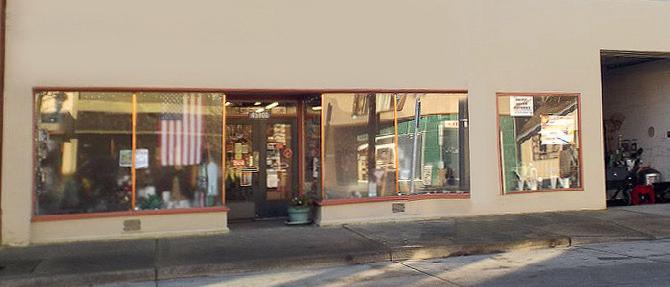

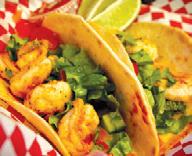






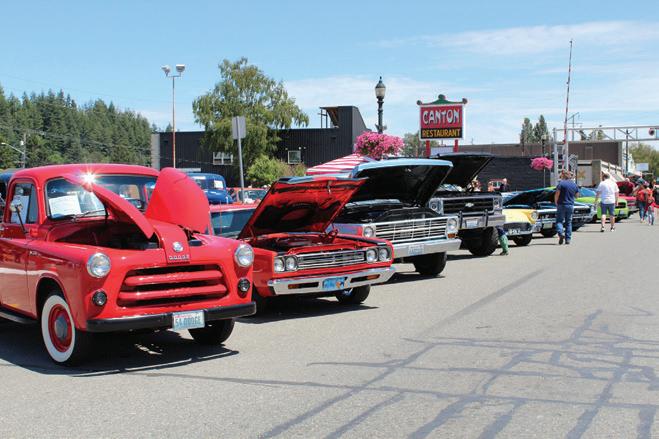
















that sometimes literally shoves its way through a few inches of wet snow. The bulbs are a significant food for bears, and for Native peoples and trappers, so one wonders how to describe the botanical impulse that makes it so conspicuous. Perhaps showy advertising for hungry mouths?
Our summertime hummingbirds, the scrappy rufous, favor its nectar in their midsummer patrols at high elevations.
There are hundreds of such individual marvels to be seen in the Pacific Northwest.
The tiny shooting star, whose intense purple and faceted-jewel shape are far showier than any actual meteorite.
The dancing blooms of golden monkeyflower, which you’ll often find growing near and even in freshets of clear snowmelt above timberline, the rushing water of mini-cascades tossing the flower
The cornflower-blue lupine that ranges from sea level to the highest ridges. Sometimes, below timberline in the montane zone, you’ll encounter such a lupine profusion in open pine forest that the delicate lush scent perfumes the woods. The Stehekin Valley hillsides are a fine place to find this phenomenon.
If you are hiking a lowland trail – say, the mesmerizing headlands of Iceberg Point on Lopez Island, where wind-trimmed old growth firs are barely 50 feet tall – keep your eyes peeled for the yellow lupine, which can form hardy shrubs three feet tall. That is, when you’re not savoring the hundred-mile views of the Strait of Juan de Fuca and the Olympic Range, Mt. Baker holding the horizon at your back.
The vivid red Western columbine, a native of almost every foothill and mountain environment, whose drooping scarlet flowers are like painted ballerinas framed against the deep green of their riparian homes. Of all the myriad flowers in the West, this is my favorite, a conspicuous sight when you find it, but only if you are looking. I’d say, for wildflowers please go here or there, but the truth is that you’d best just go anywhere. Yes, alpine meadows provide awesome displays, almost nonstop from melt-out to first autumn storm, when the snowbound sight of glacier lilies is supplanted by snow-dusted autumn asters. But we are lucky to live in a region where flowers are a nonstop attraction more than half the year.
The wildflower season begins in late March or
up into lower elevation forests in late May when you can look for bleeding hearts and trilliums in old-growth forests, and surges up to timberline as the snow retreats in July. Up here, bend down in the rocky hillsides to look for creeping phlox, a ground cover in soft pink whose spicy scent may carry just a foot from the flower.
North Cascades National Park – home of Cascade Pass – is prime wildflower territory, of course. Backpackers can set out on a three-chapter flower hike here in July, starting in temperate rainforest at the Cascade River trailhead, climbing up through timberline to the 5,932-foot pass to gawk at miles of kaleidoscopic meadow, continuing on down toward Stehekin into the pine woods of the eastern Cascades. This 21-mile ramble can be done in a day out, a day back – but not if you’re poking around in the old-growth woods seeking the elusive fairy slipper orchid, stopping for a leisurely late lunch in the alpine meadows, or marveling at the fields of fireweed blanketing recent burns on the way down into the Stehekin pinelands.
As much as I’m urging a turn away from the scenic spectacular to the close divine, it’s really not necessary to pick one or the other. Unless, like some trekkers I’ve known, the drive to, well, drive, overcomes the serene impulse to stop and chill. It’s not a race, for us.
For the infinite blossoms that nature gives just weeks to accomplish a life, it’s not a race either. It’s a never-ending story on the wheel of life, and we only need read it. x




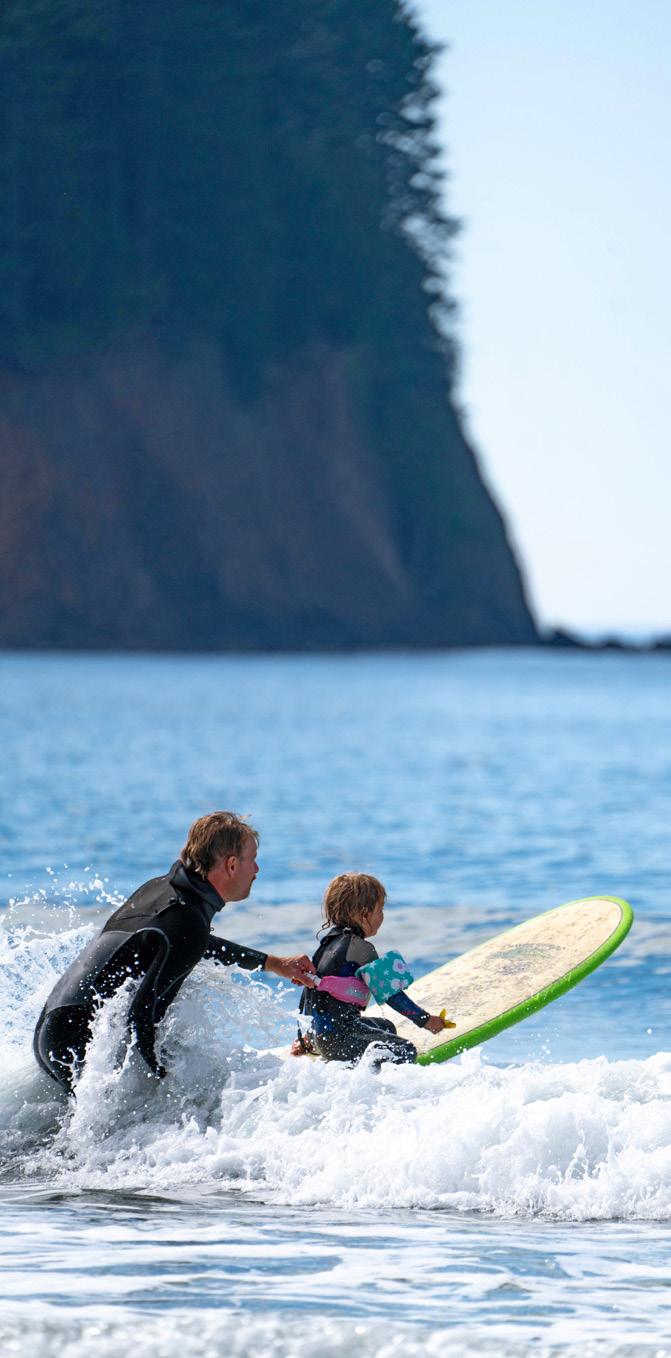






1. Allied Arts of Whatcom County 1213 Cornwall Ave. Bellingham WA 98225
Tuesday-Saturday 11am-4pm (360) 676-8548 alliedarts.org
Enjoy new shows monthly at our gallery and find gently used art supplies at our thrift store!
2. Bellingham Arts Academy for Youth (BAAY)
1059 N State St. Bellingham WA 98225 (360) 306-8531 baay.org

BAAY offers quality instruction in theatre, dance, music, and visual arts to kids and teens.
3. Bellingham Frameworks 1415 Cornwall Ave.
Bellingham WA 98225
Monday-Friday 10am-6pm, Saturday 10am-5pm, Sunday closed (360) 650-1001
bellinghamframeworks.com
Frameworks is your local choice for all your picture framing needs. All of our framing is constructed in-house, so every job is completed to the highest standards from start to finish. Whether fine art or fridge art, our team of framing professionals will help you find the perfect frame to fit your style and budget.
4. Bellingham Symphony Orchestra
316 W Champion St. Bellingham WA 98225 (360) 756-6752 bellinghamsymphony.org

Celebrating 50 years in 2025/2026 with Yo-Yo Ma, Joshua Roman, Simone Porter, the new BSO Chorus, and much more! Bellingham Symphony Orchestra is the Resident Orchestra of Mount Baker Theatre.
5. Dakota Art Store 1322 Cornwall Ave. Bellingham WA 98225
Monday-Saturday 10am-5pm (360) 676-8918 dakotaartstores.com

7. FAB
314 E Holly St. Bellingham WA 98225 (360) 933-4871 bellinghamfabstudios.com

Open monthly for art walk, and appointment. Fifteen independently owned art studios in the Fine Art Building.
8. Fourth Corner Frames and Gallery
301 W Holly St., Suite D3 Bellingham WA 98225
Monday-Saturday 10am-5:30pm (360) 734-1340 fourthcornerframes.com

Premium Quality, Innovative design since 1973! The PNW’s most experienced framers.
306 Flora St., Bellingham WA 98225
Space
Thursday - Saturday, 1-6pm (360) 933-1849
makeshiftartspace.org

Make.Shift is home to an all-ages art gallery and music venue, afordable art studios and band practice spaces, weekly workshops, and a lowpower community radio station, KZAX 94.9 FM.
1310 Commercial St. Bellingham WA 98225
Tuesday - Saturday 12-6pm (360) 746-7129
mwsoapworks.com

MW Soapworks handcrafts natural soap and skincare for healthy communities and a healthy planet. Their shop also features a rotating selection of independent artists from the PNW and beyond. Conveniently located above the Commercial Street parking garage.
12. Pickford Film Center
1318 Bay St. Bellingham WA 98225
Open daily 30 minutes before the first showtime (360) 647-1300 pickfordfilmcenter.org/home
Pickford Film Center is a two-screen (soon-tobe five screen) independent cinema nestled in downtown Bellingham, Washington.
13. Sustainable Connections
1701 Ellis St., Suite 221 Bellingham WA 98225 (360) 647-7093 sustainableconnections.org

Think Local First when shopping for your art supplies! Seach for local businesses using our online directory at SustainableConnections.org.
14A & B. Whatcom Museum
Old City Hall, 121 Prospect St. & Lightcatcher Building, 250 Flora St. Bellingham WA 98225

Wednesday - Sunday, 12-5pm (360) 778-8936 whatcommuseum.org
Art & cultural exhibitions, plus the historic Hall of Birds and Family Interactive Gallery for kids.
15. Whatcom Art Market

6. Downtown Bellingham Partnership 114 W Magnolia St., Unit 501 Bellingham WA 98225 (360) 527-8710 downtownbellingham.com
Creating a vibrant atmosphere to make downtown a key business location, visitor destination, and residential setting.
9. Hotel Leo 1224 Cornwall Ave. Bellingham WA 98225 (360) 746-9097 thehotelleo.com

Stay in style at Hotel Leo and experience Bellingham’s best at Amendment 21—where history meets hospitality. Enjoy live music, happy hour, holiday events, and Saturday & Sunday jazz brunches.
1103 11th St. Bellingham WA 98225 Daily 11am-6pm whatcomartmarket.org

Co-op of friendly local artists producing a diverse range of art works, gifts, and function items.


16. Whimsey
1001 Harris Ave.
Bellingham WA 98225
Open daily 11am-5pm & by appointment {360) 733-5568 shopwhimsey.com
Since 2003, Whimsey has offered the largest collection of local jewelry in Bellingham. Visit us in Fairhaven and online.
17. Bellingham SeaFeast
Bellingham WA 98229 bellinghamseafeast.org

Check out our events around ocean conservation, art, and more, including our FREE festival this fall: bellinghamseafeast.org/events
18. Western Washington University
College of Fine and Performing Arts
516 High St. Bellingham WA 98225 (360) 650-2829
cfpa.wwu.edu

Hundreds of music, theatre, and dance performances, exhibitions each year. Outdoor sculptures.
19. Cordata Gallery
465 W Stuart Rd. Bellingham WA 98226
Tuesday-Saturday 11am-4pm (360) 746-8745
cordatagallery.com

Cordata Gallery is a contemporary art gallery focused on representing local and national artists.
20. Pacé Atelier Art Studio
3815 Bakerview Spur Rd., Bldg 2 Bellingham WA 98226 (360) 393-1335
paceatelier.com




Pacé Atelier is a fun and inspirational art studio for kids of all ages, withvvev endless media to explore!







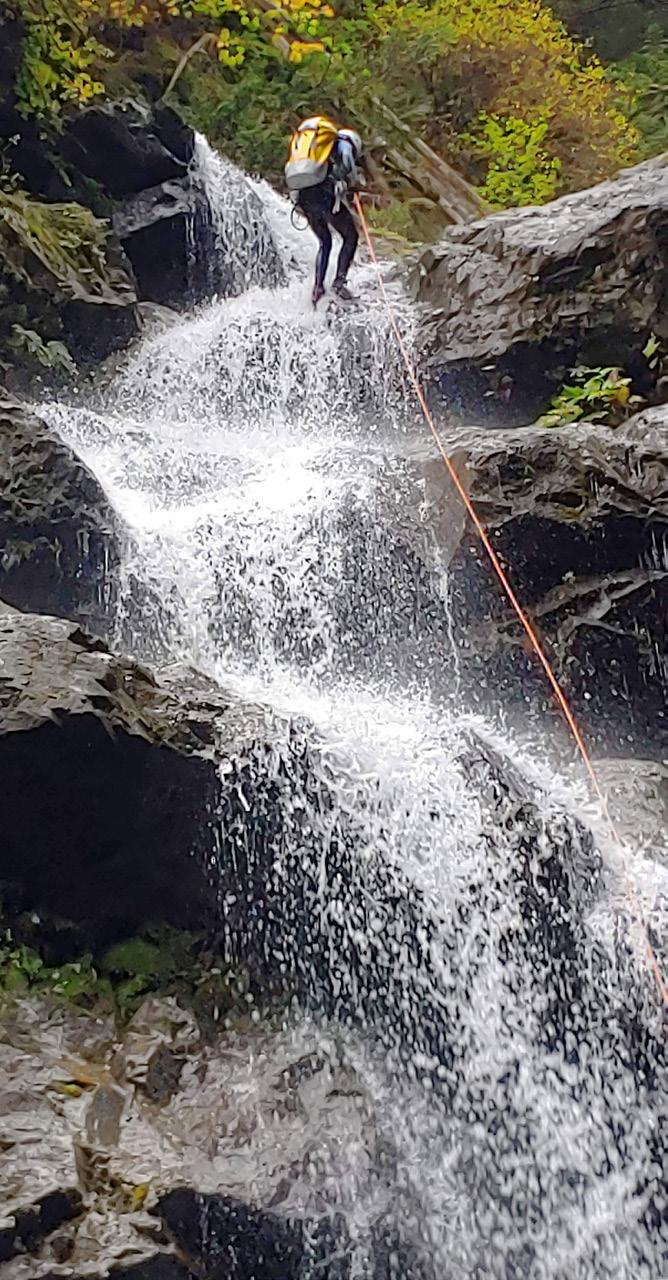
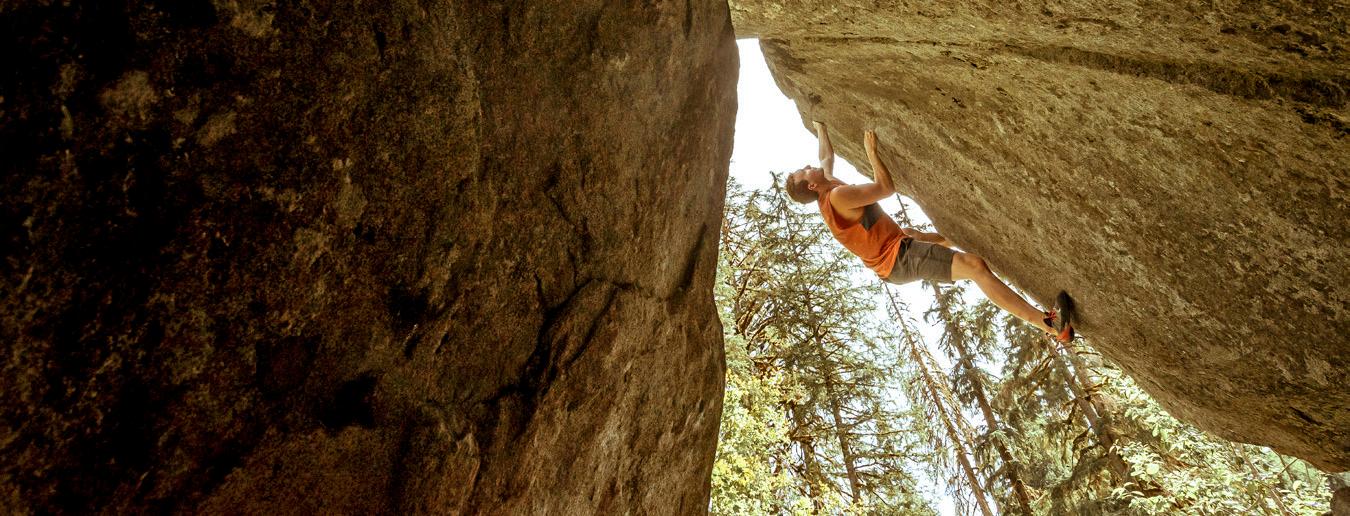




The 2025 Ski to Sea brought in athletes from around Washington, the Pacific Northwest, and the globe to experience the iconic multisport relay that spans 93 miles from the snowy slopes of Mt. Baker Ski Area to the waters of Bellingham Bay on May 25.
For the fourth consecutive year, Birch Equipment earned a first-place finish in dominant fashion, finishing each of the seven legs of the relay race in first place. The team finished with a time of 5:44.15.
Now in its 52nd year, the relay race follows a fa-
miliar yet daunting pattern of events: cross-country ski, downhill ski/snowboard, run, road bike, canoe, cyclocross bike, and finally sea kayak.
This year’s sea kayak leg was shortened slightly due to high winds, according to race organizers.
Thousands gathered around the Marine Park finish line in Fairhaven for a day of celebration, coinciding with the Historic Fairhaven Festival just up the hill.
Carless Whisper was the fastest “Car-Free” division team, meaning each member of the team completed their portion of the race without the assistance of motorized transportation. All
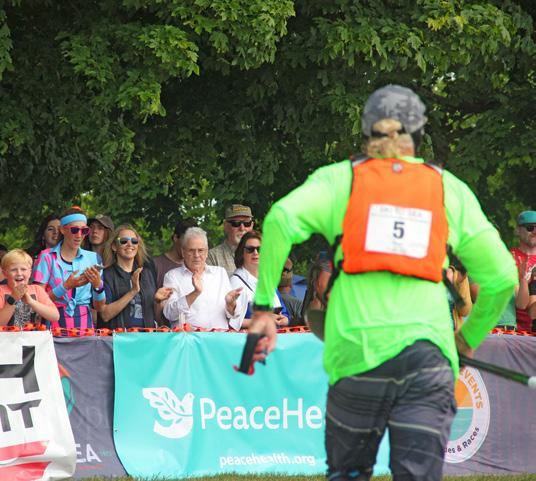
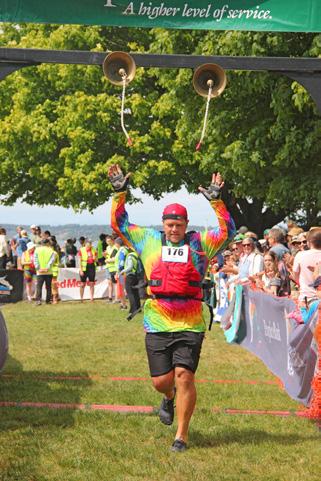
Photos by Nolan Baker
racers, support members, and their equipment (including canoes and kayaks) are transported without a car, usually by bike trailers. Carless Whisper finished with a time of 6:37.10, 12th overall.
Bellingham Flower Farm Pistils was the first women’s team to finish the relay with a time of 6:44.35, finishing 14th overall.
For the second consecutive year, Olympian paddle sport athlete Jonas Ecker competed in the sea kayak division, this time for the Nelson’s Market team, and finished with the fastest time in that leg at 21:45.5. x
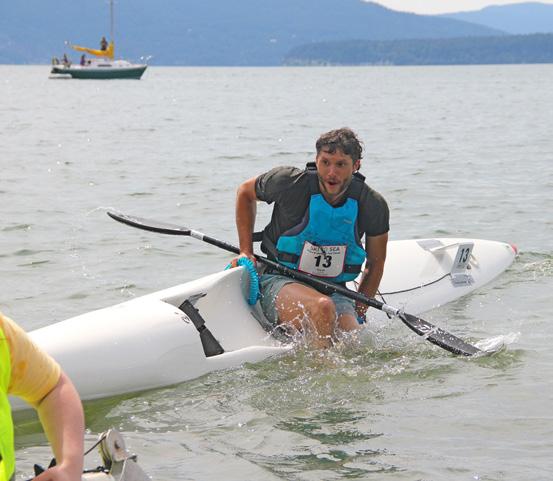

By Jake Goldstein-Street • Courtesy of the Washington State Standard
With the help of over $600,000 in state money, the sole access road to Olympic National Park’s popular Hoh Rain Forest reopened in early May after a monthslong closure.
Access on the Upper Hoh Road will be restored midday Thursday, announced Gov. Bob Ferguson. The road was washed out by the bomb cyclone that hit the region last year and has been closed since December.
The rainforest’s reopening comes just as the tourism season heats up.
Usually, the Federal Highway Administration’s Emergency Relief Program would fund repairs to the road. But then-Gov. Jay Inslee didn’t include Jefferson County, where the road is located, in his emergency declaration to unlock aid for the November bomb cyclone. This made accessing fed-
eral money difficult.
State and local officials said they didn’t have the money for repairs.
So in March, Ferguson unveiled a plan to spend $623,000 in state reserves to help fix the road, which serves as the gateway to the rainforest that saw nearly 460,000 visitors last year.
“It’s the kind of thing where, if you’re just a Washingtonian, you read an article and think ‘for god’s sake, can’t someone just figure out this bureaucracy and get the road fixed,’” Ferguson said at the time. “Because it’s a lot of money, but it’s not that much money.”
The reserve money, set aside for the governor to help businesses in need, comes from unclaimed lottery winnings. Ferguson also added Jefferson County to Inslee’s emergency declaration, so if federal funding eventually comes through, that money can reimburse the state.
Private donors contributed another $27,000 to augment the state dollars.
Heavy rains elevated the Hoh River, eroding part of the county-maintained road, causing the park to announce the closure Dec. 23. The road is located southeast of Forks, in a remote part of the Olympic Peninsula.
At the time of the closure, the county warned the road was “in imminent danger of failure.” No full-time residents live beyond the washout site. Jefferson County will celebrate the reopening at noon Thursday, when Ferguson will join local officials for a ribbon-cutting ceremony.
“This project represents a true partnership in action,” Jefferson County Public Works Director Monte Reinders said in a press release. “We’re grateful for the support of Governor Ferguson, the private donors, and our hardworking local contractors and crews.” x


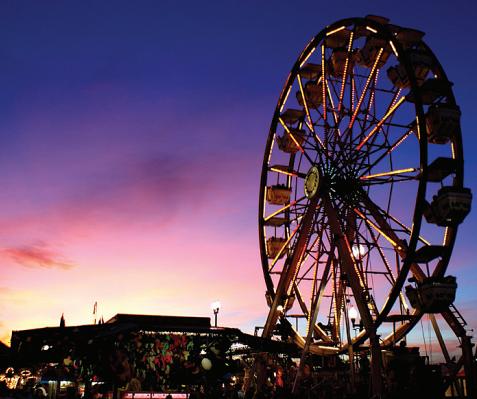







BY TONY MOCERI
For spring break, we set out in search of sun. A direct flight from Bellingham to Palm Springs was a ticket to sunny skies and hot desert weather. While playing in the pool, nighttime miniature golf, and plenty of milkshakes were on the itinerary for the week, I knew I would carve out some time for my wife, daughter and I to wander around the desert. When I first went to Palm Springs, it was more out of convenience than anything else. It was about the easiest place we could go for a vitamin D boost during Whatcom County’s grayer months. When I looked at the hills, all I saw was brown, and everywhere I looked seemed desolate.
Since then my perspective has changed as we have continued to take trips to Palm Springs and the surrounding area. I now find myself mesmerized by the surrounding mountains. Where our lush forests hide the terrain, the desert shows it off. Every ripple, rock, and ridge can be seen against the blue sky. Yes, brown is the dominant color, but now I notice shades of brown speckled with greens and grays. The highest peaks are often white, showing off their latest dusting of snow.
The earth that once seemed so dead now burst to life. Cacti dominate the scene providing bits of shade for scurrying lizards. Little blooming flowers are visited by insects, and a jackrabbit may bound across your path. Big horn sheep can be spotted on hills standing in groups as stoic figures, and with a bit of luck, a desert tortoise may stick its head from its shell to say hello. And, of course, the crafty coyote is always around to keep an eye on humans. No, the desert is not dead, far from it. It just makes you slow down and take it in to appreciate it coming to life before your eyes.
On our various trips, we have done a variety of hikes and explored Joshua Tree National Park. There are seemingly limitless places to explore in the desert. On this trip, I set my heart on exploring the Anza-Borrego Desert State Park. We had considered scrapping our plans altogether, or rather we had the night before, because of the high temperatures the area was experiencing, but when I woke up the next morning, I knew I had to go, and I was dragging my family with me. I laid there waiting for a reasonable hour before waking them up and letting them know I was back to our old plan. My wife was a good sport and jumped on board; our daughter took a little more coaxing and a little bribery; she’d get to pick the lunch spot, and we were out the door.
to have been put there for ATVs and motorcycles, as there were tracks at every turn-off. As we got into the park, we had to decide where to go and what to do. The temperature was rising, and I’m not known for planning a good itinerary for hiking. We decided to pull into the ranger station to get some advice. They were as friendly a group of people as I have ever met, but they looked at us a little side-eyed when we said we were heading out on a hike. They confirmed that we were aware that temperatures would be cresting 100°F and that we had water. We smiled and nodded. They recommended the Borrego Palm Canyon hike. It was close by, so at least we would be starting soon.
We hopped back into our rented Jeep and drove approximately two miles to the trailhead. We had to go through an entrance to a camp area where another park ranger checked to see if we had paid the $10 day use fee and to again question if we had enough water. If I’m being honest, I don’t think
seemed too perfect to be real. Walking through the desert is both quiet and loud at the same time. There are no leaves to blow in the wind, few birds to sing, and no water to rush, but the ground is loud. The hard sand and small rocks crunch with every step. Unless you are in deep sand there is little give to the earth that has been compacted for millennia. This crunch, crunch, crunch is the sound of progress when hiking on the desert’s unforgiving land. We gradually gained a little elevation as we made our way up the canyon, and our view narrowed. What was once a wide-open view of desert scape was being pinched off by the hills rising out of the canyon. As we came to our first water crossing, and I use that term loosely because it was only a couple inches deep and flowing slowly, we gave ourselves a little splash and kept going. When we found spots of shade, we took a little reprieve to get in some water before getting back to a good pace as we raced the heat.

they thought we should be heading out so late in the morning. She said there would be some water crossings so to be sure to splash ourselves on the way. We gave her a thumbs up as we drove away from her concerned face, winding our way through some nice-looking campsites before getting to the trailhead.
As our perspiration increased, so did the flow of the creek we were now following towards the oasis. With each crossing the water deepened and the trickle grew to a flow, with little waterfalls dropping below large rock formations. While the water screamed for me to jump in, I restrained myself and followed the “Stay on Trail” signs. Just as we were really starting to get hot, and my daughter was suggesting we should be at the pool, just like in the movies, the palm trees appeared. Fortunately, this wasn’t a mirage but the oasis we had been seeking. I have hiked to a handful of oases, and they are always astonishing. Somehow, in what seems to be the most barren land, where only the most adaptive of life can survive, pops a plume of green. Water flows, and life thrives while the area surrounding it struggles. The trail ended with a perched-up view of the oasis at about eye level with the palm trees. At their bases, water gurgled out of the earth at what seemed to be a randomly chosen spot. We took in the scene, snapped a few pictures, and hid in the shade for a few moments before heading back, fully aware that the temperature was only rising.
Our drive to the park entrance was about an hour, heading east on I-10 before heading south towards the Sultan Sea. Approaching the giant body of water in the middle of the desert-scape is always exciting to me. Unfortunately, the lake is unhealthy and unsuitable for recreation, but it’s still a marvel. As you turn away from the sea on Borrego Salton Sea Way, you really start to feel like you are on another planet. The terrain is more reminiscent of Mars than California. Hard rock and sand are only broken up by little canyons and hills, which appear
Once on the trail, my excitement turned to relaxation. We were finally out walking through the desert. With every step, I kept my eyes peeled for lizards and those snakes with the noise makers on their tails. We also scanned the surrounding cliffs, hoping to catch a glimpse of a big horned sheep. Spoiler alert, we didn’t see any on this hike. I stopped frequently to snap pictures of delicate flowers and fierce looking cacti, then trotted to catch up to my family who have been over-waiting for me for years.
As we wound our way towards the canyon, the slopping hills became closer, and the giant rocks that appeared to have been placed along the trail
The hike back was slightly downhill, and there were fewer pictures involved. We kept a good pace as our water bottles grew lighter and our stomachs started to rumble. Overall, the out-and-back trail is just over three miles, and I would consider it easy except for the temperatures, which can obviously be dangerous at any distance. Fortunately, the sunscreen worked, and we had enough water to get us back to the jeep so we could get to lunch before enjoying cold drinks and a good magazine by the pool.
We took a slight detour back to the visitors center to pick up a couple souvenirs. The friendly group of rangers were surprised to see us so soon and asked if we had run the trail, which we took as a compliment. While the heat dissuaded us from exploring more of the park that day or throughout the week as temperatures continued to rise, I plan to return soon to explore more of the Anza-Borrego Desert State Park. Next time, I plan to spot some big horn sheep and start a little earlier. x
By Mike Nolan
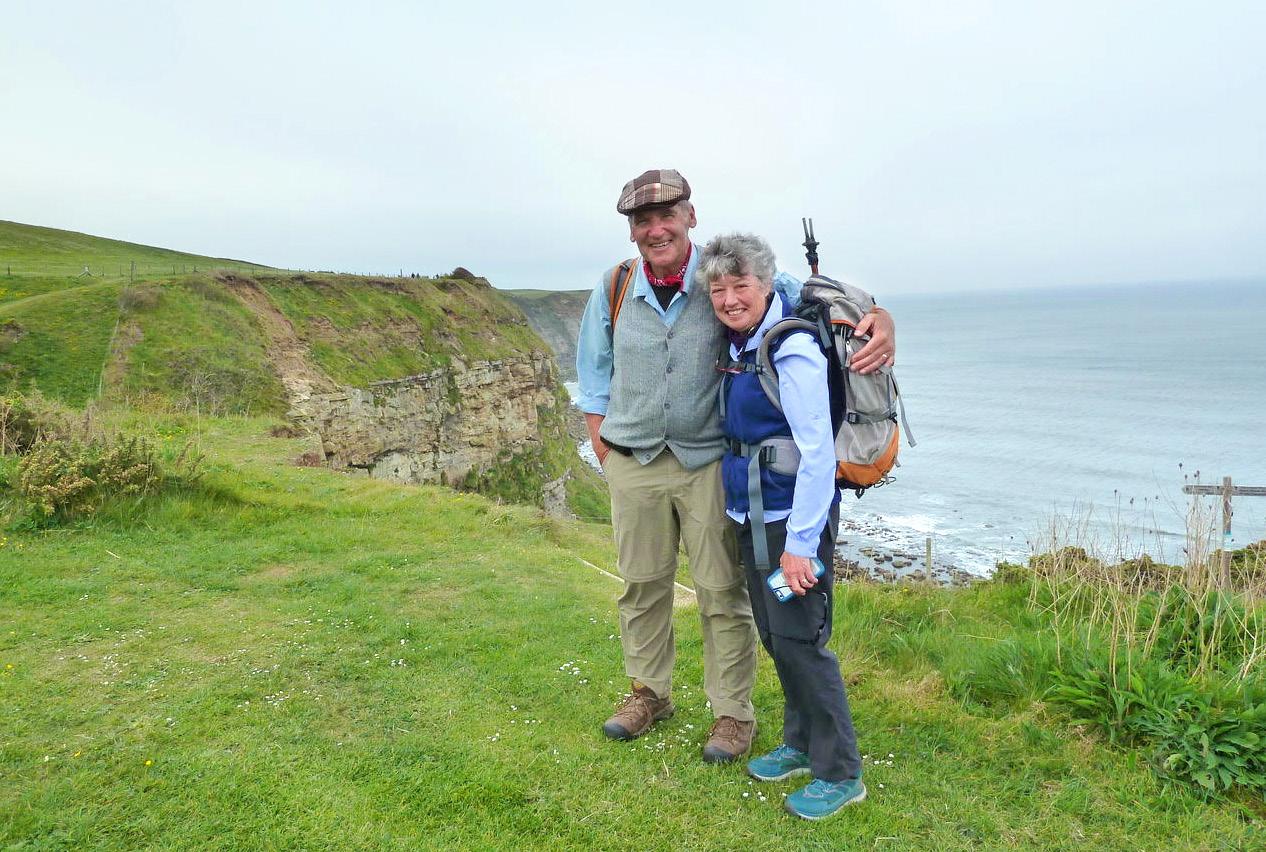
The idea of walking across an entire country – crossing from one coast to the other – was a magnet to me, pulling me to read Alfred Wainwright’s guidebook, A Walk Across England. With more than 40 hiking books to his credit, Wainwright was the country’s preeminent fell walker, “fell” referring to elevated, untamed ground. Also, while we say “hike,” the English say “walk” or “ramble.” After years of rambling through the English countryside, Wainwright curated a walk in 1973 based on the scenery he found most appealing. His path became one of the most popular long distance hiking trails in the United Kingdom, and attracts about 6,000 people every year. Wainwright’s signature trek, known simply as the “Coast to Coast,” stretches across Northern England from the shores of the Irish Sea on the west coast, to the North Sea on the east. The walking path traverses three national parks at just under 200 miles long. With two weeks vacation time, my wife Ann and I set out to experience this lovely swath of England.
Our adventure began in the west, at the small town of Saint Bees. Overlooking the rolling waves of the Irish Sea, Ann and I walked down to the shore and dipped the soles of our hiking boots in the water – a ritual associated with the beginning of the Coast to Coast. Our hope was to dip them in the waters of the North Sea at the end of our walk.
We traveled light by taking advantage of a “bag-
gage service,” allowing us to just shoulder rucksacks. For a small fee, our larger bags were picked up in the morning and delivered to the next stop each day. Initially, we were hesitant to use a baggage service (we’re hiking purists, I suppose) but in the end we were glad we did. In fact, we found it to be the norm on the Coast to Coast trail.
The trail began as a beach walk, but quickly ascended the rust-colored sandstone bluffs of Saint Bees Head, eventually rising to a flattened tabletop carpeted in green. On the way up, we enjoyed commanding views of the shoreline. Ann and I then turned inland, making our way through sheep pasture gates and past a lighthouse. The landscape was charming, pastoral, and remote; we practically had the trail to ourselves.
Wainwright chose his route based on scenic beauty, not on the uniformity of the trails. The Coast to Coast is a conglomeration of hiking paths, rock scrambles, bridleways, fenced sheep pastures, open fields, and the occasional country road: all granted public right-of-way. Turns and twists in the footpath might be marked by a weathered wooden sign post – clearly visible –but other times more discreetly by a hand-drawn message on a flat rock or the side of a barn (sometimes as simple as “C2C” with an arrow). Ann and I weren’t always sure we were on the trail, but the ambiguity added to our sense of adventure and exploration.
The Coast to Coast is mapped out in twelve daylong stages by Wainwright. We gave ourselves a
little more time with two weeks, averaging twelve to fifteen miles a day depending on terrain and elevation gain. Our shortest leg was nine miles, our longest twenty-three. All but one of the stages ended near overnight accommodations. Wainwright purposely avoided cities when mapping out this route, which meant Ann and I usually lodged at small inns, bed-and-breakfasts, or pubs that had upstairs rooms. These places welcomed hikers, usually offering a packed lunch to purchase at check out. Because these were “small town” accommodations, it was easy for us to make connections with local folks. Doing this made us feel we were seeing more of the “real England” beyond what we experienced in London.
And, of course, we got to know other hikers. After two or three days on the trail, Ann and I had trekked enough miles to recognize familiar faces. We would stop to rest and have someone pass us, only to pass them further down the trail when they took a break. Sharing a common goal, a nodding acquaintance developed, and it wasn’t long before Ann and I looked forward to wrapping up a day’s march at the local pub with our new fellow-hiker friends, where we’d compare hiking stories over a pint in front of the fireplace.
We met two British men well into their sixties, Army buddies, they told me. There was an Australian couple who, like us, got into long-distance scenic walking as a retirement activity. We got to know three women from Virginia who met one another in college as sorority sisters and stayed
in touch. And there were three English brothers, now living in different parts of the country, who were doing the walk to spend more time together. “And we’re still talking to one another,” the oldest brother said. “Well, so far,” the youngest brother added with a grin.
Over the next couple days, we traversed hilly terrain, climbing the main watershed of England, which breaks east and west. With lots of ascents and descents, we knew we were in the heart of the Lake District, the most challenging section of the hike, and the first of three national parks we would cross. The views of steep rocky trails and pristine mountain lakes (“tarns”) were breathtaking. Ann and I approached Kidsty Pike, the demanding ascent leading to the highest point of the route (2,560 feet), and from that point began our descent into the Dales.
The Yorkshire Dales – our second national park – was characterized by undulating green hills and farmland, a welcome relief for our stiff hiking legs. Ann and I crossed a limestone plateau on our way to Kirkby Stephen as we recalled the land’s literary connections (lovingly described by James Herriot), and talked about the quaint village names (Danby Wiske), making our way to Swaledale and the northern end of the Vale of Mowbray.
We stopped in the market town of Richmond (with a population of 8,000 people, the closest we ever got to a “city” on the walk) and toured Richmond Castle, which overlooks the River Swale. From there we hiked into the North York Moors National Park area.
The food on the trail was hearty, down-home fare. B&Bs tended to be large affairs, usually consisting of eggs, “rashers” (slices of bacon or ham), baked beans, stewed tomatoes, black pudding (blood sausage), tea and toast. In the evenings, Ann and I found the pub food inviting: shepherd’s pie, Yorkshire pudding, fish and chips, and bangers and mash. To me the Moors had a moody quality: long, rolling stretches of land covered in low growing, deep purple heather. Or maybe it was the literary connection again, this time to “Wuthering Heights” and “The Hound of the Baskervilles.” The
territory felt wild and unyielding.
The next few days saw us heading toward the rocky coastline and, eventually, the trail’s end at Robin Hood’s Bay. The town of the same name, a picturesque fishing village overlooking the North Sea, is where we walked to the shoreline and triumphantly dipped our hiking boots, completing our trek.
The custom is to have a celebratory drink at the Bay Hotel. Built in 1828, the hotel is situated atop a slipway overlooking the bay, serving as the traditional terminus of the trail. You’ll find the Wainwright Bar on the first floor, and can order a beer named in his honor.
We entered the crowded, noisy bar and were immediately greeted by the three British brothers, who pointed and hollered, “They made it!” The brothers then motioned us over, adding, “We saved seats for you.”
Shouldering our way to our seats, pints in hand, Ann and I waved to the Australian couple, saluted the two British Army buddies, and sat across from the three American women from Virginia. Ann and I surveyed the smiling, now familiar faces, all of us clearly pleased in our achievement.
One of the women from Virginia leaned over to Ann and said, “We’re sitting in a small-town pub in England, and I know more people here than I would in a bar back home!”
So, you really can walk across an entire country while experiencing beautifully changing landscapes. For us, the path was sometimes challenging but always rewarding. If you decide to take on this iconic hike, you’ll find navigation a little easier: the British government recently declared Wainwright’s Coast to Coast a “National Trail,” which means they are upgrading the path and installing standardized, uniform signage scheduled to be completed by the end of 2025.
Although this is a popular trail, there were many times Ann and I surveyed the magnificent scenery before us and didn’t see another soul. We both highly recommend that anyone take this unforgettable challenge, experience three of Northern England’s wonderful National Parks, and enjoy one of the most spectacular hiking adventures in Great Britain. x
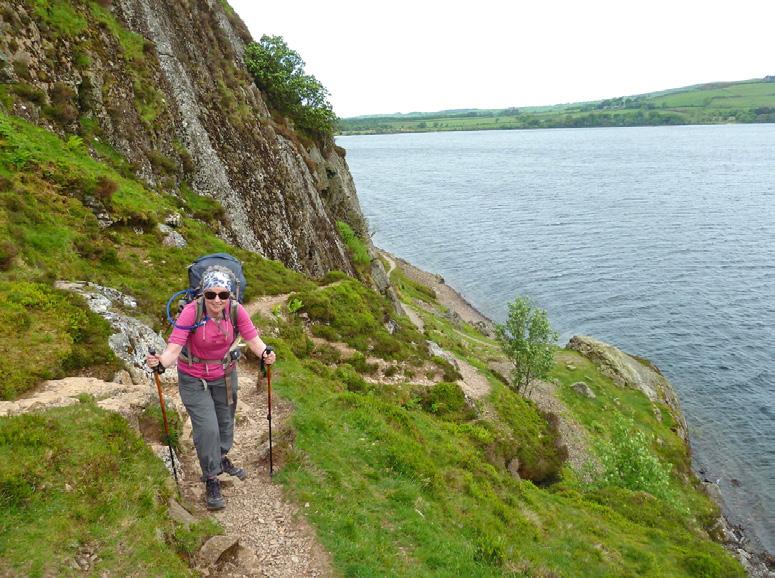

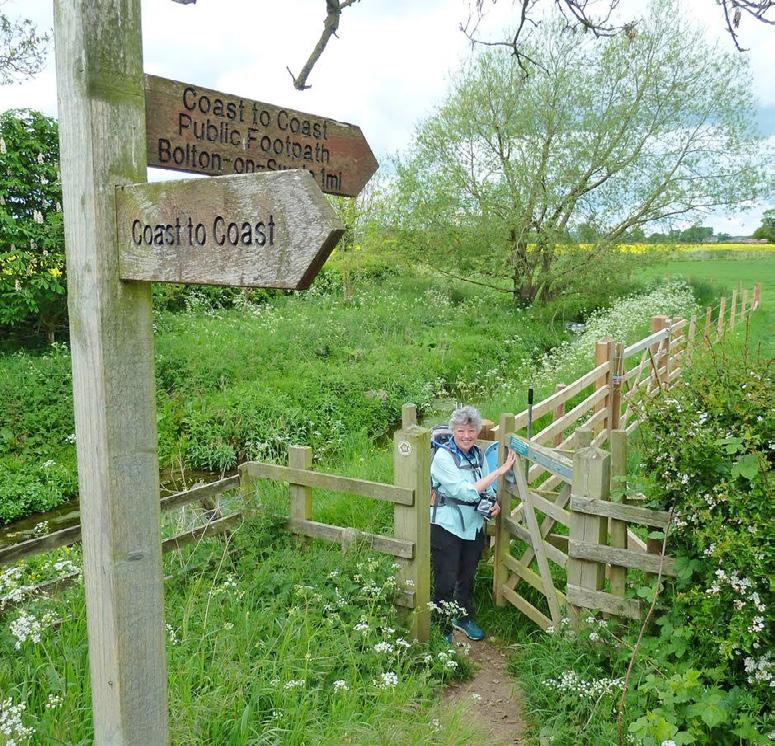


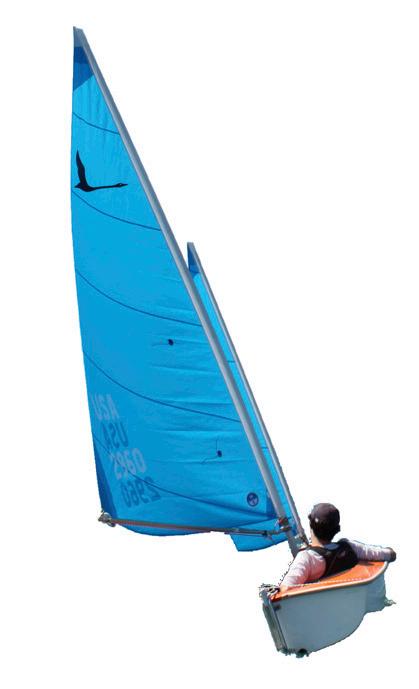


The Bellingham Community Boating Center (CBC) is set to host a vibrant lineup of summer events, offering opportunities for all ages and abilities to engage with Bellingham Bay. From May through September, the CBC’s Community Sessions provide inclusive, low-cost, and often free programs designed to foster connection and enjoyment on the water.
Warriors on Water (Mondays, May–October): A therapeutic paddling program for veterans and their families, promoting camaraderie and healing. Participation is $15, with advance registration required.
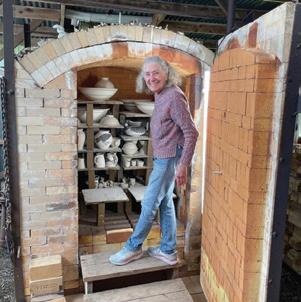

Find special treasures for gifting paintings, drawings, prints, notecards, jewelry, photography, sculpture, glass, woodwork, pottery, metalwork, stonework, quilts, clothing, knitwear, and more! For self-guided tour maps & details, follow us on


/Lummi Island Studio Tour
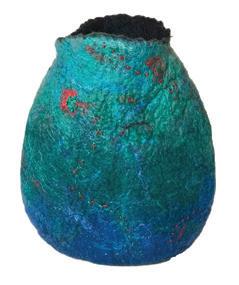
Wild Women Paddle (Wednesdays, May–September): In partnership with Shifting Gears, this session offers women-led sunset paddles on Bellingham Bay. All skill levels are welcome, and equipment is provided. Sessions are free but require advance registration.
Adaptive Splash (Thursdays, May–September): A collaboration with The AIROW Project, Max Higbee Center, and Cascade Connection, this program offers adaptive paddling experiences for individuals of all abilities. It’s free and open to all ages.
Pride Paddle Out (Fridays, May–September): A weekly casual paddle for the 2SLGBTQIA+ community, featuring kayaks, paddleboards, and a mega SUP. Participation is $10, with equipment provided.
Beats on the Bay
Experience live music on the water with CBC’s “Beats on the Bay” series. Paddle out with your own kayak or reserve one from the CBC fleet to enjoy performances from local artists. Upcoming dates include August 20 with Rubatano Marimba and August 28 with The Inside Strait.
For a more relaxed experience, tickets are available to enjoy the concert from the deck of the Schooner Zodiac.
For youth aged 9–14, the CBC offers an Adventure Sailing Summer Camp August 8–12. This camp provides hands-on sailing instruction, fostering teamwork and a love for the water. The camp runs daily from 10 a.m. to 4 p.m. Scholarships are available.
All these events reflect the CBC’s commitment to fostering small-watercraft education, safe recreation, and marine stewardship on Bellingham Bay. For a full calendar of events and more information, visit boatingcenter.org x
Pacific Northwest rock guru, artist and guide Alison Jean Cole brought us two new, and very different, books in the last year. They make a good pair nestled next to your rock pick.
Beautiful Rocks & How to Find Them (Princeton Architectural Press, 2024) is less a guidebook and more of an invitation to discover the Earth’s treasures and stories wisely and responsibly. Rocks are everywhere, and when you visit a place, Cole aims to give you the tools to understand the earth you are standing on. How were the rocks made and what are they made of? What is the story they tell of the time since they were made? She also aims to make sure your rockhounding adventures are safe, legal and sustainable by offering practical advice for trip planning and collecting, from reading geological maps to what you can take from public lands. Cole’s own intimate and engaging writing combines with quotes from other rockhounds making the book feel like dropping in to a conversation of rock lovers.

A Rockhound’s Guide to Oregon and Washington (Mountaineers Books 2005) is the guide book its predecessor isn’t, offering detailed information about 60 sites in the region, from lava flows to ancient sea floors, along riverbanks or beaches to high plateaus. The geologic history of each site explains how what you’ll find there was formed, how it arrived at the location and the story of its journey. Each entry includes a map, directions, what agency controls the site, conditions to expect and what tools make sense.
Mountaineers Books released a Rockhounding Logbook concurrently with Cole’s guide that continues their tradition of making sturdy logs for recording your outdoor adventures. x

n Nearly 7 miles of pristine beaches
n Stunning ocean views of the Gulf & San Juan islands
n Miles of park trails
n Marina & 18-hole championship golf course
n Waterview restaurants
n Campground, Airbnb & VRBO
n Short drive from Tsawwassen Ferry
n Easy access to Vancouver, BCSURREY



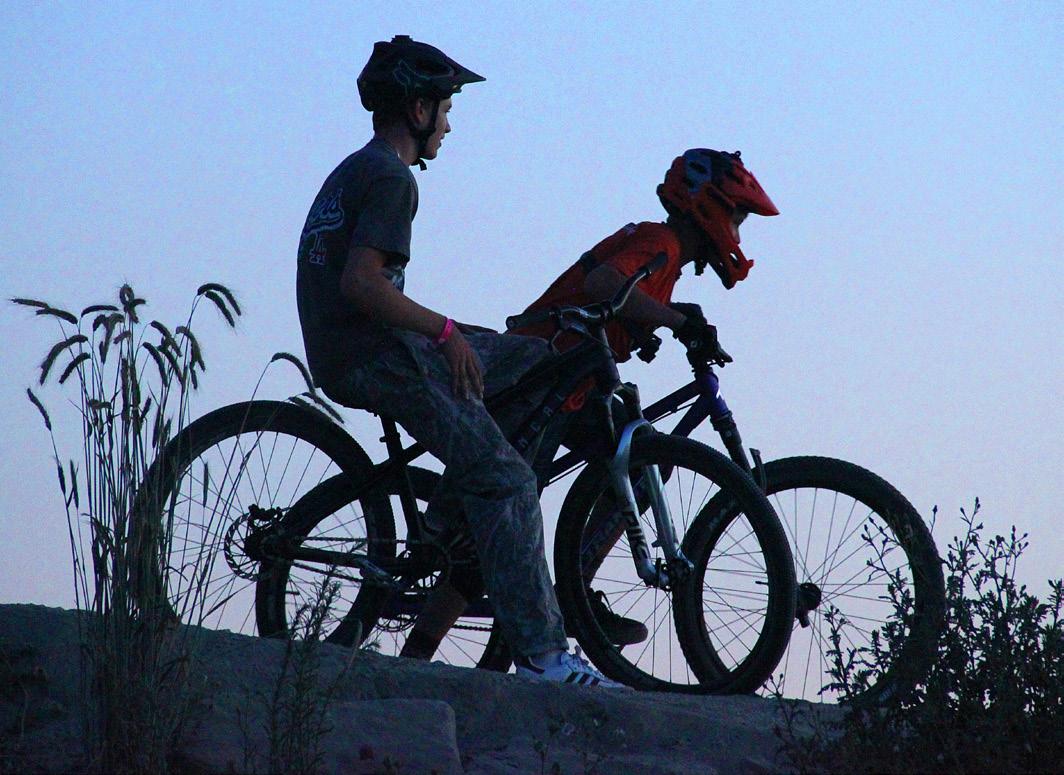
Each summer, Bellingham’s waterfront transforms into a high-octane playground during the Northwest TuneUp, a three-day celebration of the region’s vibrant outdoor and cultural scene. This unique festival fuses mountain biking, craft beer, and live music into an experience that
feels authentically Pacific Northwest. Set against the stunning backdrop of Bellingham Bay, Northwest Tune-Up isn’t just a festival, it’s a full-blown lifestyle showcase. Bikers from across the West Coast flock to the site for worldclass races, pump track showdowns, and freestyle stunt exhibitions. With the nearby Galbraith
Mountain trails just a short ride away, it’s a mecca for riders of all skill levels.
But it’s not just about the bikes. The beer garden, stocked with selections from the region’s best craft breweries, offers the perfect pit stop.
Festivalgoers can sip a hoppy IPA or a refreshing lager while soaking up sunshine and catching sets from a diverse lineup of musical acts – ranging from indie rock and folk to hip-hop and electronic.
Local food trucks, gear expos, and family-friendly activities round out the weekend, creating an inclusive atmosphere that brings together diehard cyclists, casual fans, and curious newcomers alike.
Northwest Tune-Up is more than a festival – it’s Bellingham’s love letter to adventure, community, and the joy of a perfect summer day. Whether you’re here to ride, relax, or rock out, this is one event you don’t want to miss.
This year’s headliners include electronic-funk pioneers Sound Tribe Sector 9 on Friday night and indie rock favorites Silversun Pickups on Saturday night. Other standout acts include hip-hop legends The Pharcyde and Brother Ali, indie-pop band HARBOUR, and psychedelic rockers TEKE::TEKE.
Single day, and full weekend tickets are available online now at nwtuneup.com. x

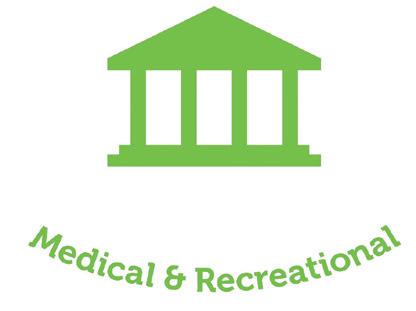

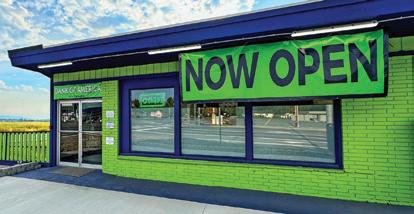




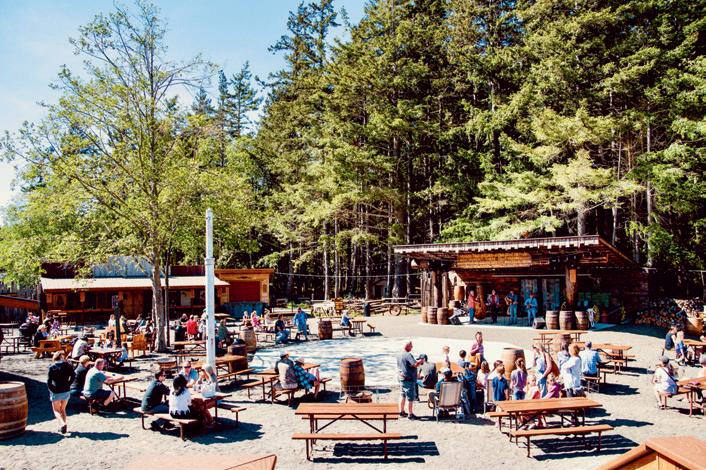









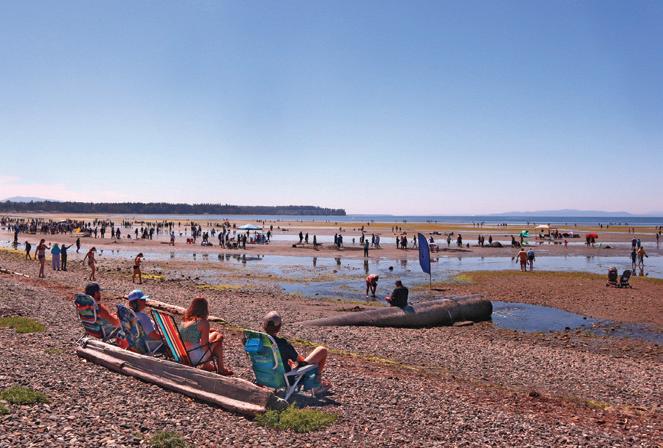







PACKERS KITCHEN & BAR AT
SEMIAHMOO RESORT
9565 Semiahmoo Parkway
360/318-2090
semiahmoo.com
Seaside dining with stunning views and a fresh menu of seafood, hand-crafted pizza, and local specialties.
BELLINGHAM CIDER COMPANY
205 Prospect Street, Suite A105
360 /510-8494
bellinghamcider.com
A local craft cider producer and solar-powered restaurant with a full bar overlooking Bellingham Bay. Food is prepped fresh and sourced from local farms and businesses.
BOUNDARY BAY BREWERY & BISTRO
1107 Railroad Ave
360/647-5593
bbaybrewery.com
A family-friendly community hub. Unwind in the taproom, bistro, deck or beer garden with handcrafted brews, fresh local food.
HOLLY’S MEAT PIES
4073 Hannegan Rd.
360/778-1111
hollysmeatpies.com
Washington’s original pasty company. Artisan hand pies made from scratch. Order online.
SKAGIT’S OWN FISH MARKET
18042 Hwy 20
360/707-2722
skagitfish.com
Offering the highest quality in local seafood. Daily lunch specials freshly prepared. Local jams, jellies, salsas, honey and sauces.
ANNIE’S PIZZA STATION
44568 State Route 20
360/853-7227
anniespizzastation.com
Family-owned pizza restaurant focusing on fresh, homemade quality Italian fare. Friendly service, helpful information and great food combine for an unforgettable experience.
THE NORTH FORK BREWERY
6186 Mt. Baker Highway
360/599-2337
northforkbrewery.com
Handcrafted beer and hand tossed pizza. Order online for to-go orders. New covered beer garden. Weekday Happy Hour Mon-Fri 12-5 p.m.
SILVER REEF CASINO RESORT
4876 Haxton Way
866/383-0777
silverreefcasino.com
Diverse dining options from woodstone pizza to award-winning fine dining at The Steak House.
GUNNERS TEX MEX BBQ
9990 Mt. Baker Hwy
360/599-0783
gunnersbbq.com
Succulent, fresh smoked meats, order by the pound or dish. Burgers, tacos and vegan option. Beer, wine, craft cocktails.
WAKE ‘N BAKERY
6903 Bourne Street
360/599-9378
getsconed.com
Open daily from 7 a.m. to 6 p.m. serving breakfast burritos & sandwiches, quiche, soup, paninis, and freshly baked goods. Savory and sweet gluten-free and vegan options. Organic espresso and coffee.
SKAGIT VALLEY FOOD CO-OP
202 S. 1st Street
360/336-9777
skagitfoodcoop.com
Deli food from scratch using fresh, quality ingredients, sourced from local and organic suppliers whenever possible. Entrees, side dishes, soups, salads, sandwiches, and handmade, organic ice cream. Vegan, vegetarian, raw, gluten-free, and whole food choices for every meal.
SEMIAHMOO RESORT
4565 Semiahmoo Parkway
360/318-2000
semiahmoo.com
A casual northwest beach resort surrounded by the Salish Sea. An authentic Pacific Northwest experience for everyone – from families looking for a fun getaway to couples and friends seeking an easy-going retreat.
SILVER REEF CASINO RESORT
4876 Haxton Way
866/383-0777
silverreefcasino.com
Exit 260 off I-5. 206 luxurious rooms or suites to make yourself feel at home with beautiful Mt. Baker views, complimentary breakfast, free WiFi.
LUXURY GETAWAYS
10005 Mt. Baker Hwy.
360/398-9590 or 877-90-BAKER
luxurygetaways.com
Redefining the cabin in the woods. Vacation rentals in the heart of the Mt. Baker Recreational Area – perfect for hitting the slopes or relaxing.
SERENE MOUNTAIN ESCAPES
360/961-0123
serenemountainescapes.com
Quality vacation rentals that sleep from 1-12 guests. Choose from pools, hot tubs, dog friendly & more.
SUMMIT PROPERTIES AIRBNB’S RAVEN’S NEST @ MT BAKER MT BAKER MOONSHINE CABIN
206.794.0775
summitproperties.realestate
Experience top rated luxury cabin rentals in Glacier Springs near Mt Baker Ski Area Book on AIRBNB or from summitproperties. realestate
THE KNOTTY LODGE
360/303-2887
VRBO.com/563675
Premier Mt. Baker vacation rental. 3BR, 2BA luxury timber home with modern amenities, hot tub, WiFi, gourmet kitchen, fireplace, fire pit. Your perfect getaway base camp!
MT. BAKER LODGING
7425 Mt. Baker Hwy.
800/709-7669
mtbakerlodging.com
Find your perfect accommodations - from rustic to luxury getaways, from studio to 12+ bedrooms. Open 7 days a week.
Since 1986, Mount Baker Experience magazine has inspired outdoor enthusiasts of all ages throughout Washington and British Columbia.
MBE gets readers outside - it’s the publication outdoor enthusiasts turn to when they need a hit of adrenaline. Increase your exposure with the Northwest’s premier adventure magazine. Seattle to Vancouver.
Next issue: Fall 2025
To be part of the experience call 360-332-1777 or email sales@pointrobertspress.com www.MountBakerExperience.com
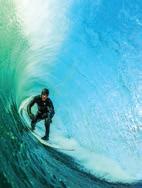
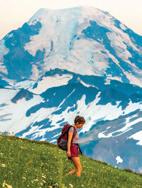
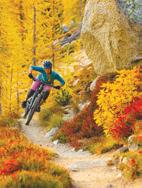
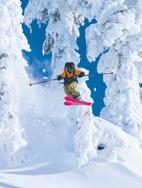
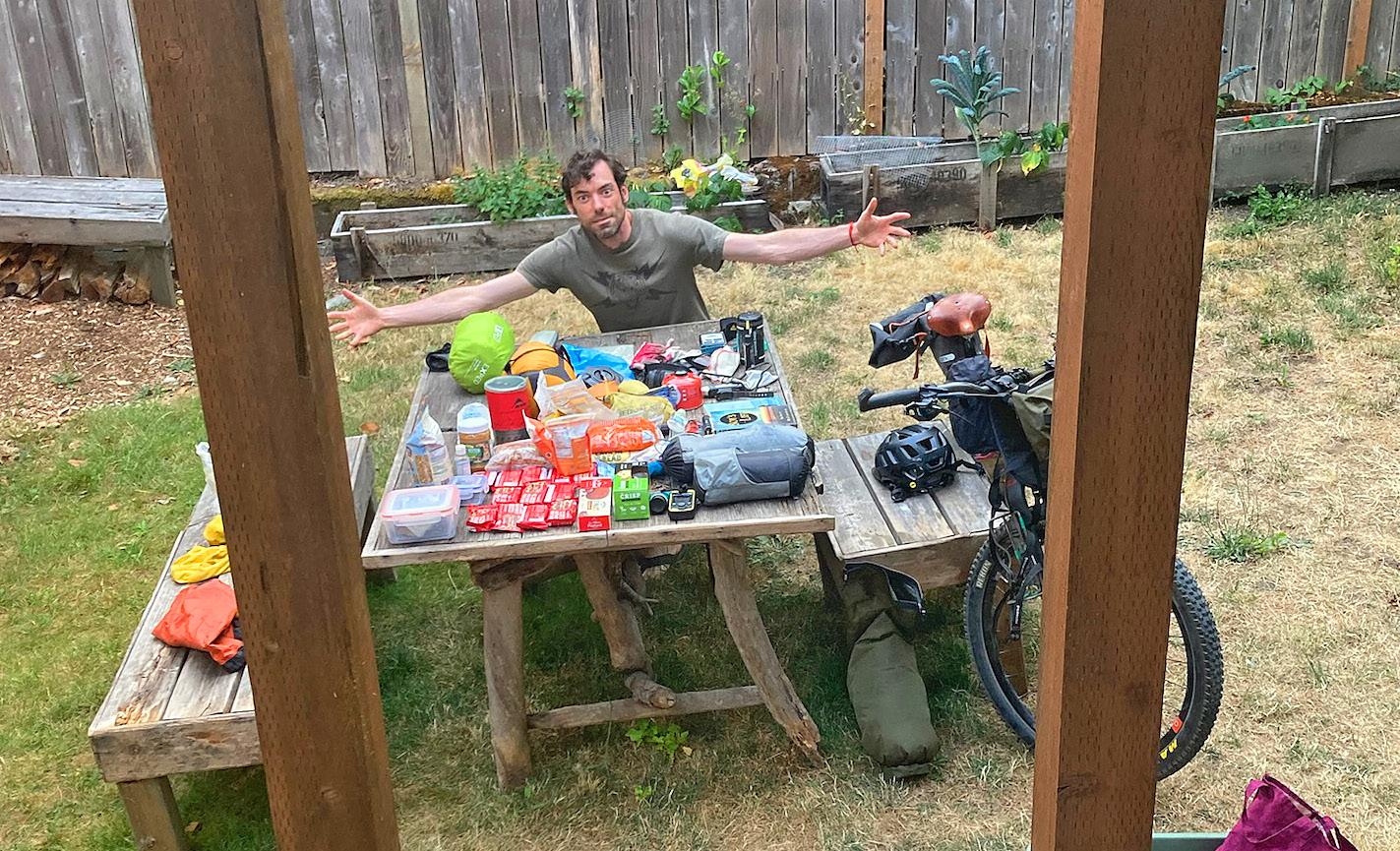





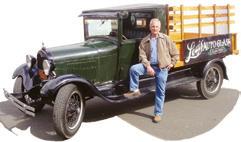

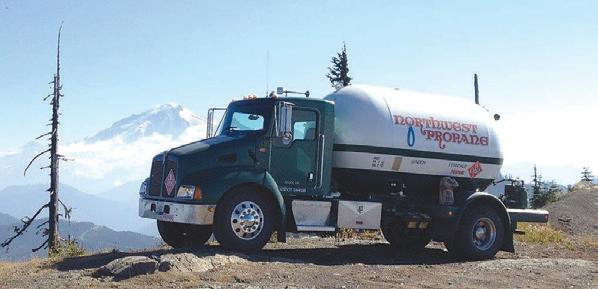

Sunday, May 25
Ski to Sea is the original multisport relay race, from Mt. Baker to Bellingham Bay. Organize your team of 3-8 racers and join us on Memorial Day weekend. Celebrating 52 years. Info: skitosea.com.
Sunday, June 1
The Swedes discovered SwimRun in 2006. It consists of swimming and running and swimming and running. The Bellingham SwimRun will be held at Lake Padden and offered as a 15K and 5K. Racers can compete solo or with a team. Info: questraces.com/bellingham-swimrun
June 6
Race from Tacoma to Port Townsend in 48 hours. The rules are simple: no motors, no support and no wind—human power only. Pedal, paddle or row. Info: seventy48.com
Saturday, June 7
The ultimate Galbraith Mountain bike race. Do the 33 miles, 5,200 vertical on your own or divide into segments with
one or two teammates. Info: questraces. com
June 7-8
The largest running event on the Olympic Peninsula. A USATF certified course and a Boston Marathon qualifier. Info: nodm.com
JON PASS OUT:
Saturday, June 14
Quilcene. For endurance riders it’s one part of the Gravel Unravel endurance bicycle series on the gravel road systems of the Olympic and Kitsap peninsulas. Info: peninsulaadventuresports.com
Saturday, June 28
A 360-ish mile loop from Port Townsend to Port Townsend through Washington’s waterways on engineless craft, Wind and Muscle Group divisions. Route makes its way via Bellingham Bay and off Point Roberts. Info: nwmaritime.org
July 11-13
A bike, beer and music festival celebrating PNW culture on the Bellingham waterfront. Family friendly events. 3-day festival passes, which include access to endless bike demos, award-winning headliners, bike and skills clinics, shuttles to trailheads, as well as single day admission. Info: NWTuneUp.com.
Saturday, July 12
An Olympic-distance triathlon that is a USAT sanctioned event. The race includes a 1500-meter swim on Lake Whatcom, 40km bike ride along North Shore Drive and Y Road, and a 10km run around the trails of beautiful Whatcom Falls Park, with the transition area and start/finish lines at Bloedel Donovan Park. The event draws beginner to elite athletes, in individual and relay divisions, and includes an expo area for athletes and spectators. Info: lakewhatcomtriathlon.com.
Saturday, July 19
Enjoy all that the Northwest has to offer in one ride — Mt. Baker, Lake Whatcom, valleys, rivers, farmland and beaches. Rides vary from 22 to 100 miles. Join the
post ride party at Boundary Bay Brewery. Info: tourdewhatcom.com.
TRIATHLON:
Sunday, August 17
Includes a 800 meter swim on Lake Padden, 9K mountain bike loop along the Lake Padden horse trails, and finishes with the classic 4.1K (2.6 mile) gravel loop trail around Lake Padden. Transition area will be on the grass near the old baseball fields at Lake Padden Park. Beginner to elite friendly and you can do it with friends as a relay. Info:bellinghamoffroadtri.com.
Saturday, September 6
Great Olympic Adventure Trail Run is a point-to-point half marathon, marathon, and 50K trail race that traverses Kelly Ridge between the Olympic National Park and the Strait of Juan de Fuca. Port Angeles. Info: peninsulaadventuresports. com.
Sunday, September 14
Ascend 4,462’ from Chair 9 in Glacier to Artist Point (5,140’ elevation) in 22 miles along the Mt. Baker Highway. One

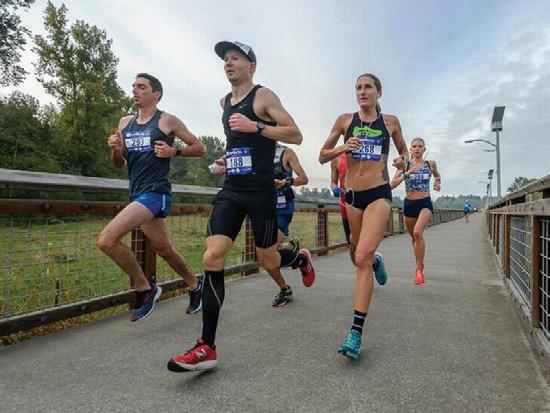





of the most scenic paved roads in the country. Steep elevation but the views are stunning. Experience the agony and the ecstasy. In top 10 Grand Fondo Hill Climb Events. Info: bakerhillclimb.com.
BELLINGHAM BAY
MARATHON:
Sunday, September 21
Also, half Marathon, 10K and 5K races. Often called one of the most beautiful races in the Pacific Northwest. Info: bellinghambaymarathon.org.
THE BIG HURT:
Saturday, September 27
A premier multi-sport race on the Olympic Peninsula. A four-leg test of endurance, strength and tenacity intertwined with the beauty of the North Olympic Peninsula. The event starts with 15-mile mountain bike, followed by 2.6-mile kayak, 30-mile road bike and a 10K run along the scenic Olympic Discovery Trail, Port Angeles. Info: bighurtpa.com.

SHOESTRING CIRCUS
June 6-22
Bellingham. Featuring incredible acts and circus artists from around the country. A dazzling fusion of art, spectacle, skill and absurdity all under the classic big top! Info: shoestringcircus.com
BELLINGHAM DOCKSIDE MARKET
First and third Saturdays at Squalicum Harbor. Local fisherman sell their catch and harvest direct to you! Info: bellinghamseafeast.org/dockside-market
BELLINGHAM SCOTTISH
GATHERING:
Saturday, June 7
Blaine. 200 competitors in dance, athletics, piping and drumming. Info: scottishdancesociety.org
DEMING LOGGING SHOW:
June 14 & 15
Deming. 62nd annual benefit for busted up loggers. 31 events, world champion speed climbing. Info: demingloggingshow.com
BERRY DAYS
June 20-22
Burlington. Celebrating Burlington’s history, agriculture, farming, traditions and community. Info: burlingtonchamber.com
BIRCH BAY KITE FESTIVAL
June 21 & 22
A weekend of high-flying for all ages. Info: birchbaychamber.com

BIRCH BAY SAND SCULPTURE COMPETITION
July 26
A day of creativity and fun. Talented teams and individuals transform the beach info a gallery of incredible sand sculptures: Info: birchbaychamber.com

Points by sheraton 714 Lakeway Drive | BeLLingham wa 98229 saturday, July 19, 2025 5:00 P.m










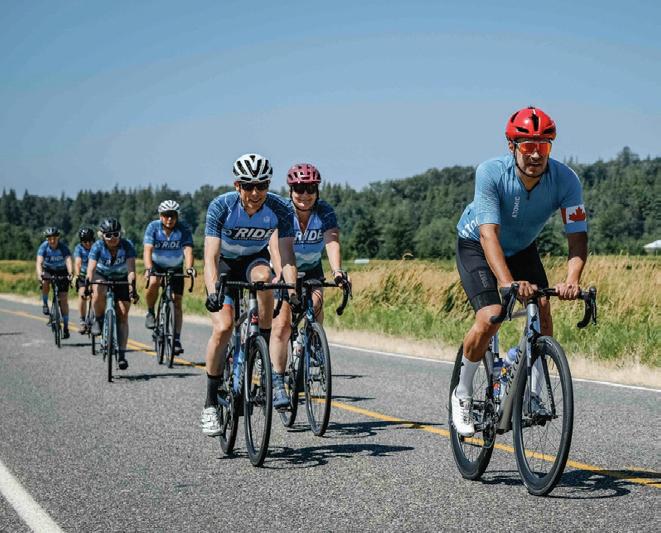







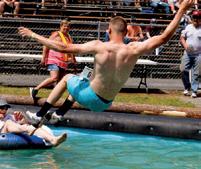



Blaine. The best July 4th event north of Seattle. Parade, 100+ vendors, music, car show. Spectacular fireworks over Semiahmoo Bay. Info: blainebythesea.com
NORTHWEST TUNE-UP:
July 11-13
A bike, beer and music festival celebrating PNW culture on the Bellingham waterfront. Family friendly events. 3-day festival passes, which include access to endless bike demos, award-winning headliners, bike and skills clinics, shuttles to trailheads, as well as single day admission. Info: NWTuneUp.com.
STRINGS & THINGS MUSIC FESTIVAL
July 12
Point Roberts. A full day of high-caliber string-driven acts in picturesque Point Roberts with Juno award-winners, The Paperboys; party-folk-rockers, The Whiskeydicks; 11-piece symphonic rock powerhouse, The Living Orchestra; violin looping virtuoso, Gabriel Wheaton aka “The Red Fiddler”; Canadian-American bluegrass supergroup, Bordergrass Alliance; and southern banjo-shredding troubadour, Quattlebaum. Info: stringsandthingsmusicfestival.com
NORTHWEST RASPBERRY FESTIVAL
July 18 & 19
Lynden. Did you know Whatcom County is the top producer of raspberries in the United States?! Annual event celebrates the crop and economic impact that raspberries have in the area. Info: lynden.org
SURREY FUSION FESTIVAL
July 19 & 20
Surrey B.C. is named the Cultural Capital of Canada. This kaleidoscope of culture is a true feast for the senses and a perfect way to soak up Surrey’s diversity in one colorful weekend. Info: discoversurreybc. com
WHIDBEY ISLAND FAIR
July 24-27
Langley. 100th fair. Parade, entertainment, 4H. Info: whidbeyislandfair.com
ART BY THE SEA FESTIVAL
July 26 & 27
Blaine. Vibrant outdoor market of local and regional artists. Info: blaineartscouncil.org
ANACORTES ARTS FESTIVAL
August 1-3
Hosting more than 220 booth artisans, producing a highly acclaimed art show. Entertainment, food and beer/wine vendors, and a youth area dedicated space for kids and family activities. Info: anacortesartsfestival.com
DRAYTON HARBOR PIRATE FESTIVAL
August 2
Blaine. Family-fun maritime festival with crafts for the kids, sea-shanty theater, scavenger hunts, and pet contest. Info: blainebythesea.com
BIGFOOT FESTIVAL
August 2
Maple Falls. Celebrating all things Bigfoot. Live music and vendors. Info: maplefallspark.com
August 7-16
Lynden. Top musical performers, rodeo, variety of animal exhibits, including large and small animals, horse show, car show. Info: nwwafair.com
SUBDUED STRINGBAND JAMBOREE
August 7-9
Deming. 25th annual. Dedicated to nurturing a strong local music community while connecting national and international folk, roots, and emerging musicians.
Info: stringbandjamboree.com
COUPEVILLE ARTS & CRAFTS FESTIVAL
August 9 & 10
One of the oldest arts & craft festivals in the state promoting quality handcrafts and the arts. Info: coupevillefestival.com
JEFFERSON COUNTY FAIR
August 8-10
Port Townsend. This year’s theme: National Parks. Showcasing the region’s unique and thriving farming heritage with amazing animals and horse events, Info: jeffcofairgrounds.org/fair
NORTH CASCADES BLUEGRASS FESTIVAL
August 30 & 31
Deming. Labor Day weekend filled with great bluegrass! Festival hosted by the Kruger Brothers featuring music workshops. Performances also by Full Cord, Burnett Sisters Band, Fog Holler, Jackson Hollow, Paper Bluegrass Revival, Roosevelt Road and North Cascades Bluegrass Band. Campground facilities. Info: ncbf.fun
Education
Family






















